Early Electric Guitars
Many of the earliest instruments with electric pickups were lap steel guitars made in the mid 1930's by Rickenbacher, Gibson, and a few other companies such as National.
Rickenbacher Lap Steel Guitars and Amplifiers
Rickenbacher A-22 Fry Pan Lap Steel Guitar
The earliest electric lap steel made with the Rickenbacher name, which later changed it's spelling to Rickenbacker, with a "K", was made from aluminum. It is known informally as the "fry pan", due to it's shape. Like the best of all pre-war Rickenbachers, the fry pan has a 1 1/2" wide "horse-shoe" pickup, which is considered to be one of the best sounding pickups of any made to date. The narrower 1 1/4" pickups found on post-war Rickenbachers are less desirable and sought after. The earliest examples of the "fry pan" have a volume control only. A tone control was added later.
Rickenbacher A-22 Fry Pan Lap Steel Guitar
Volume control only. 1 1/2" horseshoe pickup.
Serial number 045.
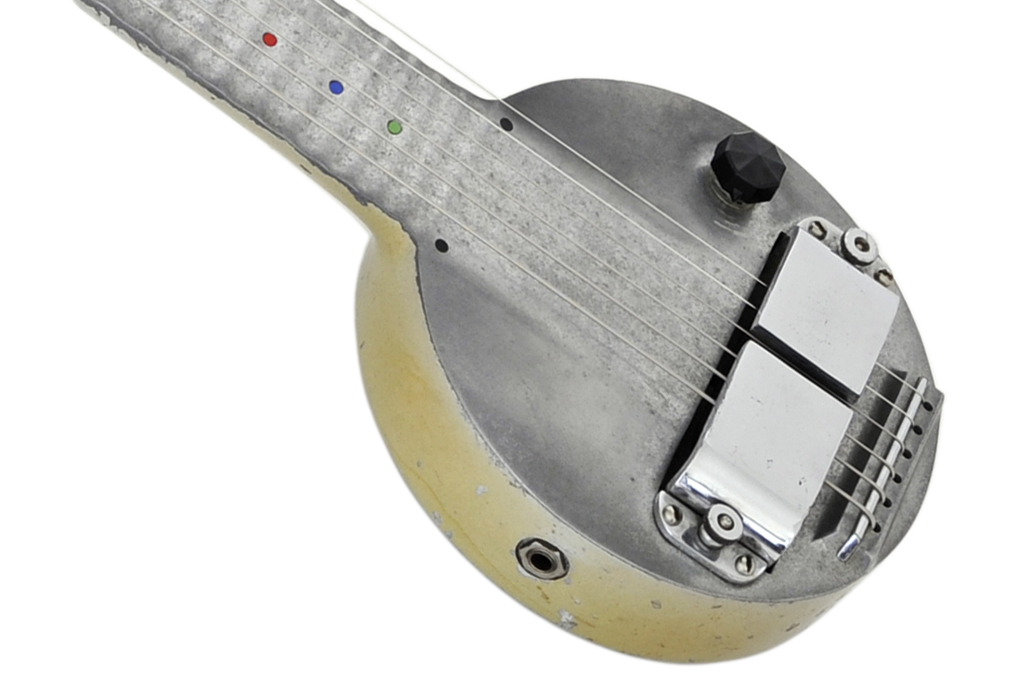

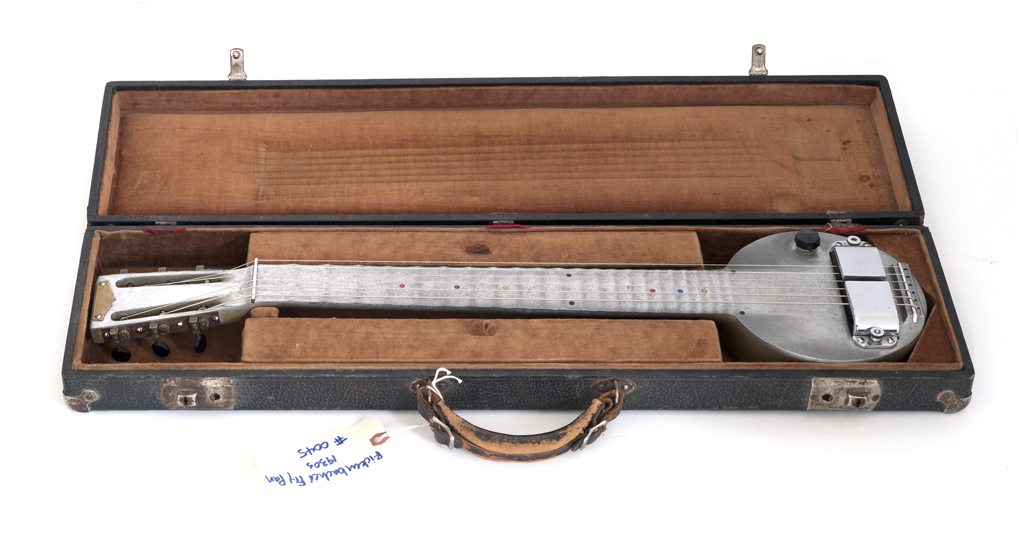
1934 Rickenbacher Amp
#B37
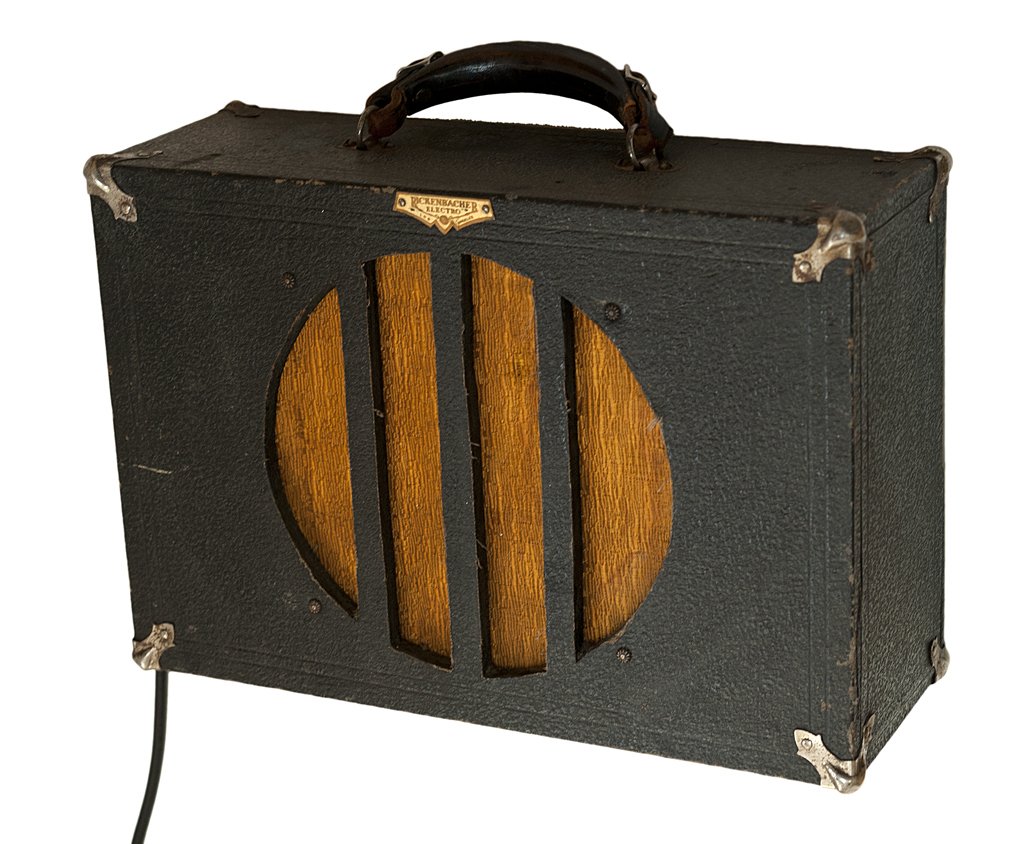
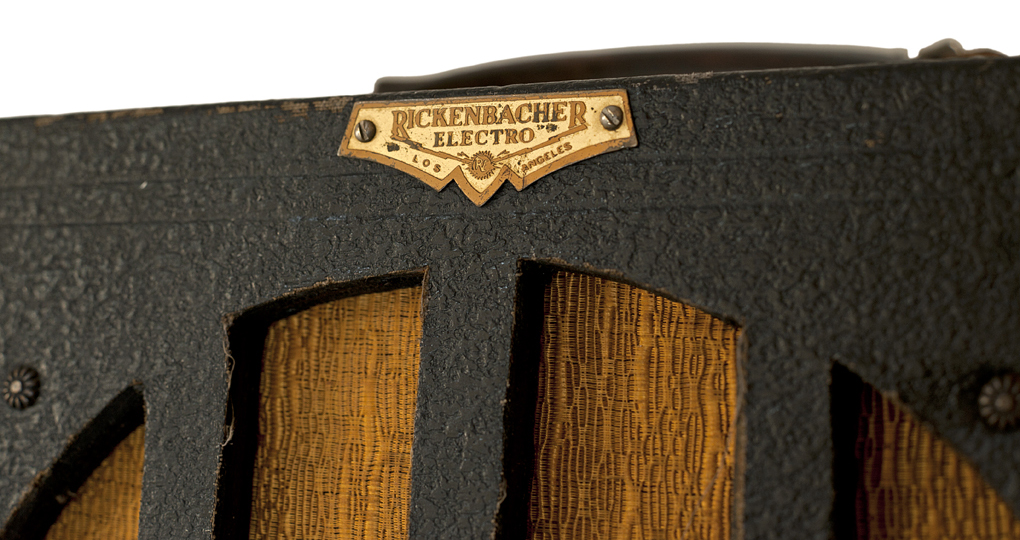
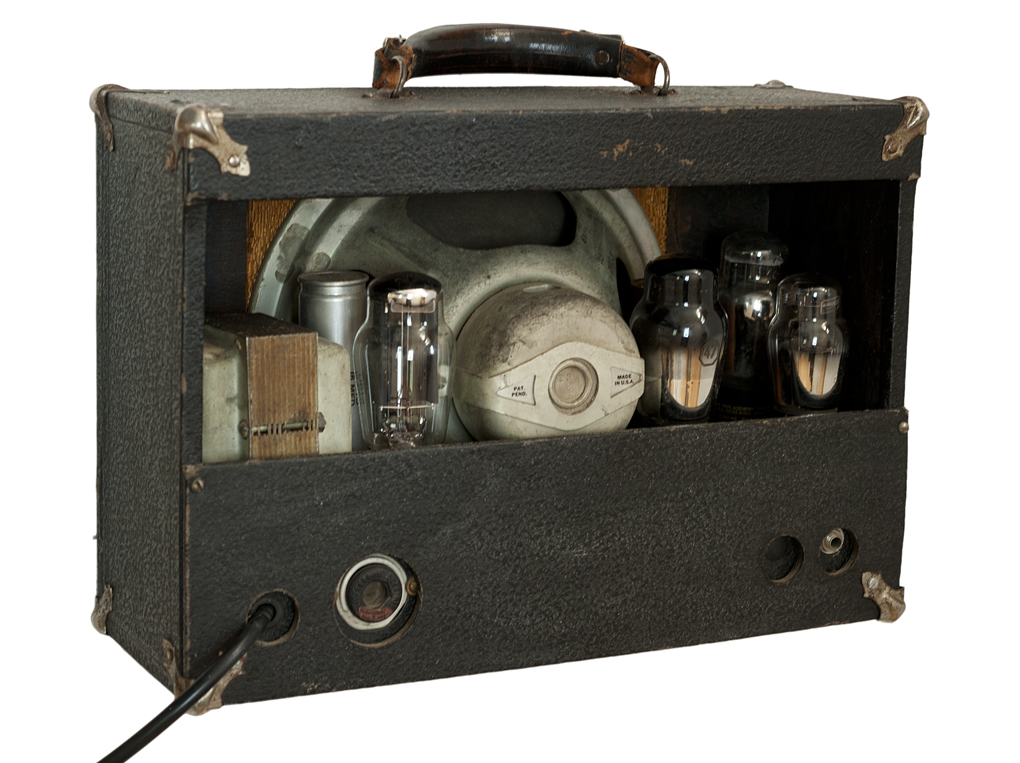
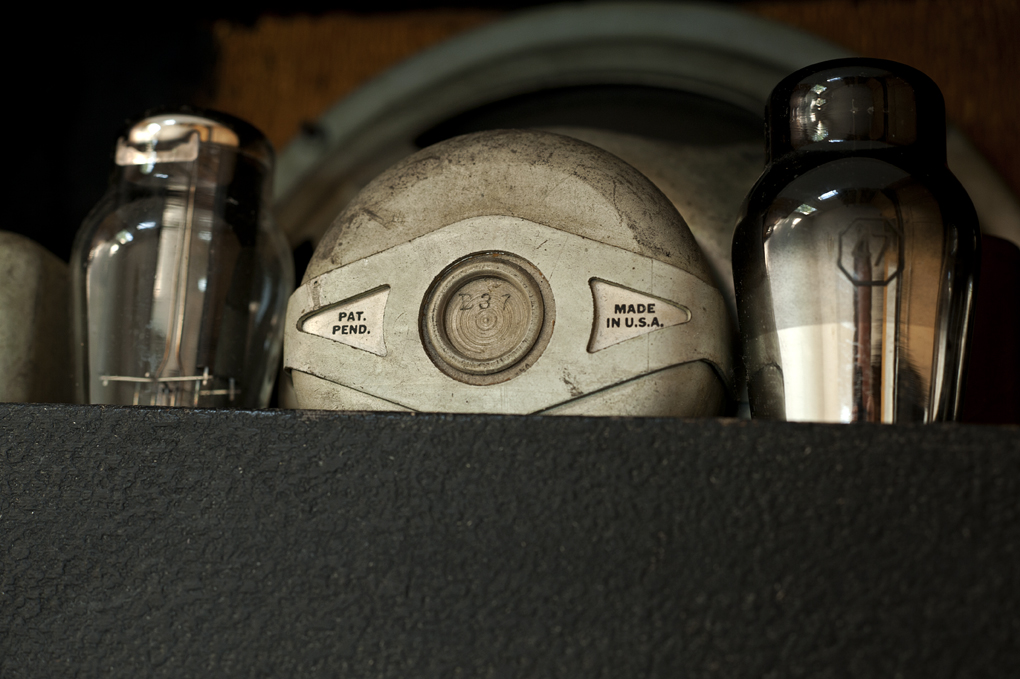
1934 Rickenbacher Amp
#A12
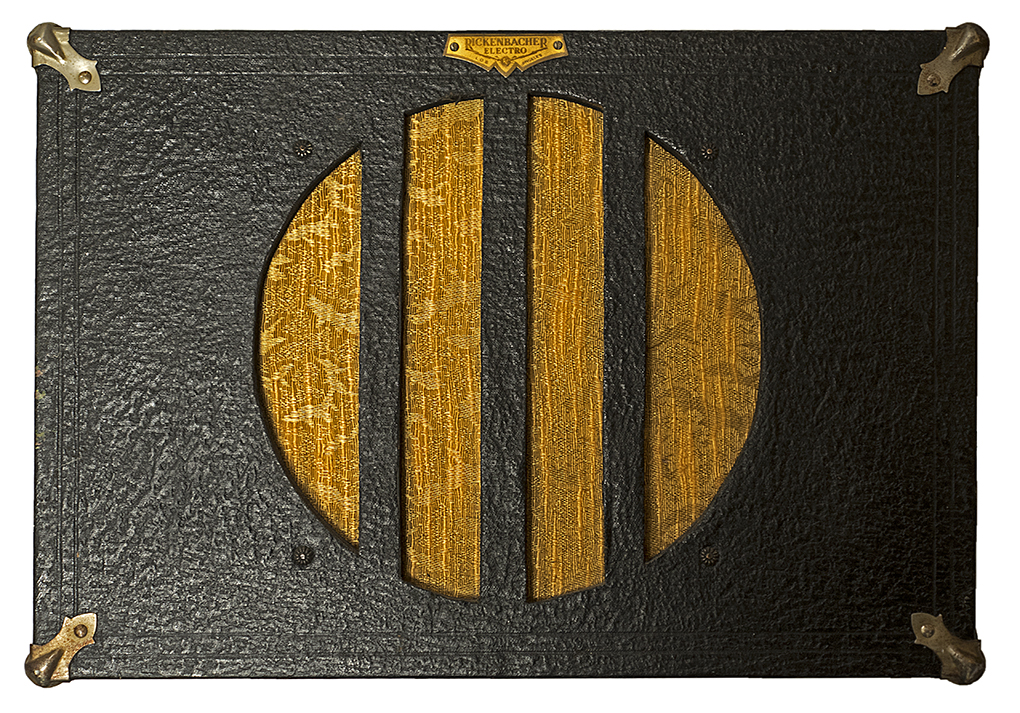
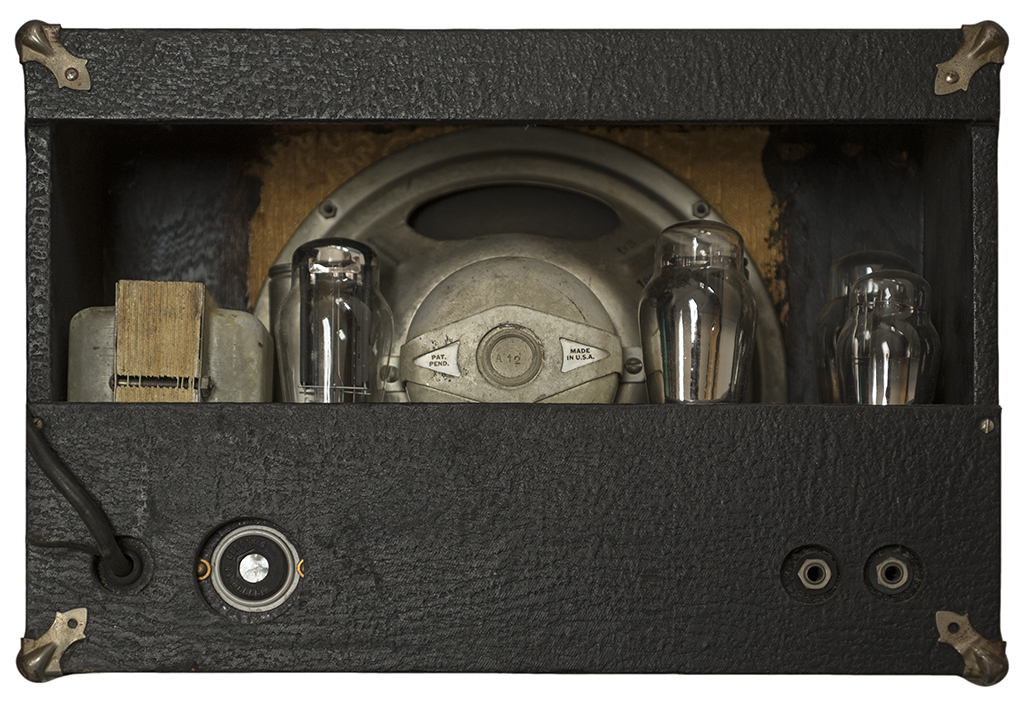
Rickenbacher A-22 Gold Plated Fry Pan Lap Steel Guitar
Volume and tone control. 1 1/2" horseshoe pickup.
Serial number 1107.
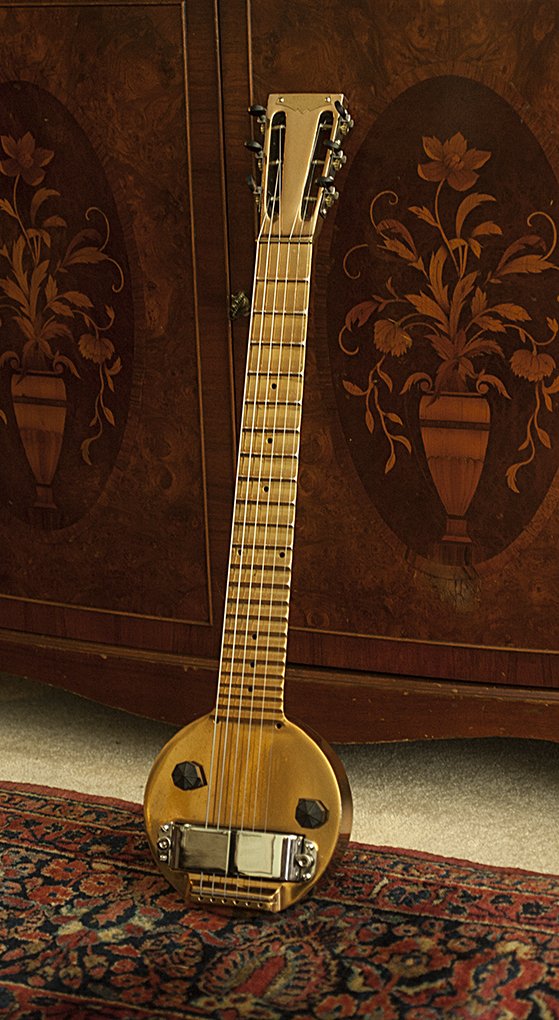
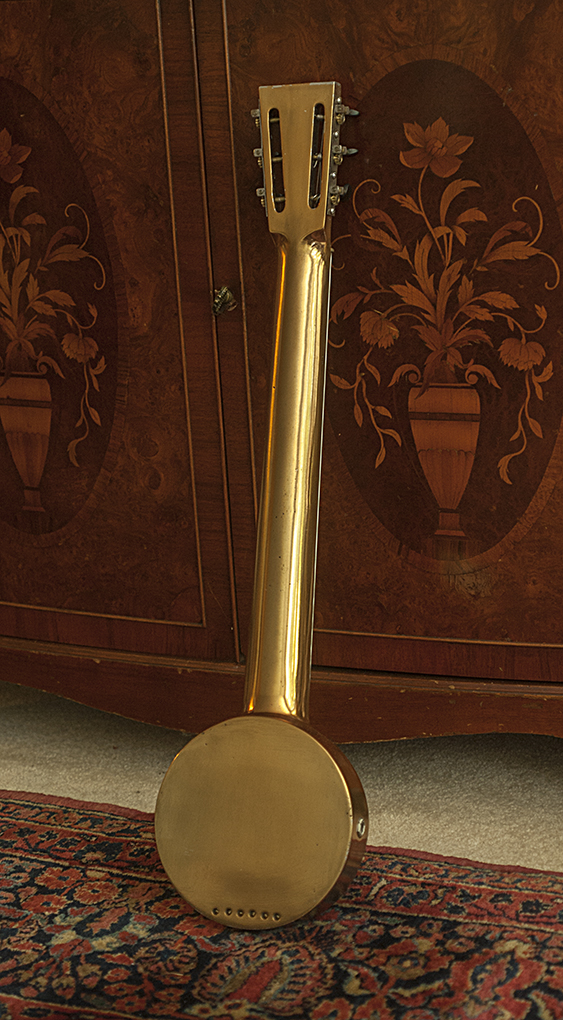
Rickenbacher Electro Model B Lap Steel
While the fry pan remained in production for many years, Rickenbacher soon added another model with a body made from Bakelite.
The earliest of these, made in the mid-1930's, had five chrome plated metal plates.
Rickenbacher Electro Model B Lap Steel
Pre-war bakelite steel with two "arrow" knobs on opposing sides, the volume knob larger than the tone knob, and chrome plates. One replaced tuner.
8 lb. 9.8 oz.
Serial number C1366
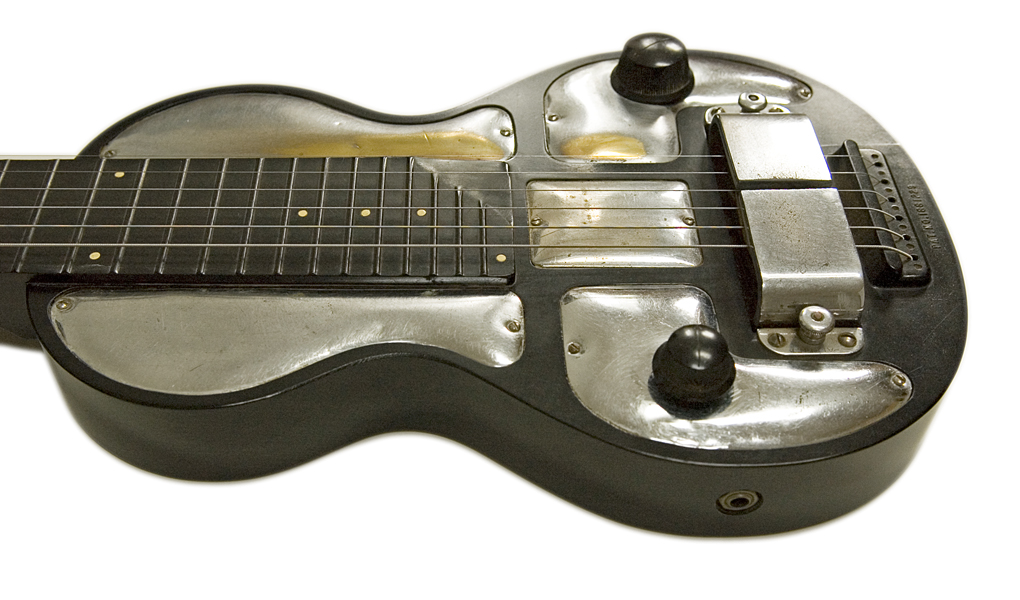
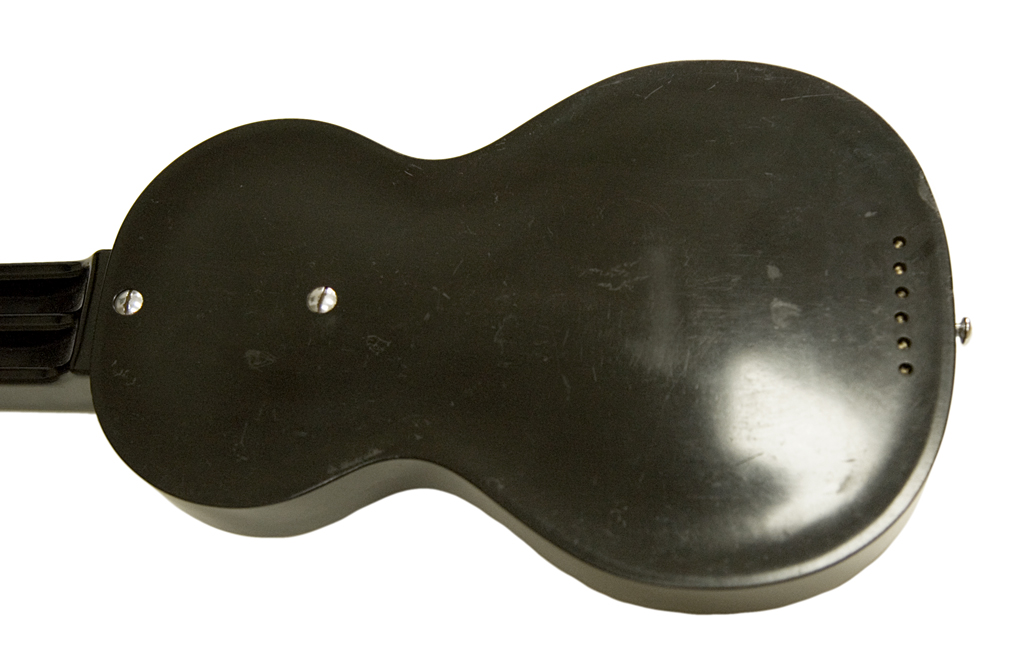
Rickenbacher Electro Model B Lap Steel
Pre-war bakelite steel with two "arrow" knobs on opposing sides, and chrome plates. Original hard case.
Serial number C 2164
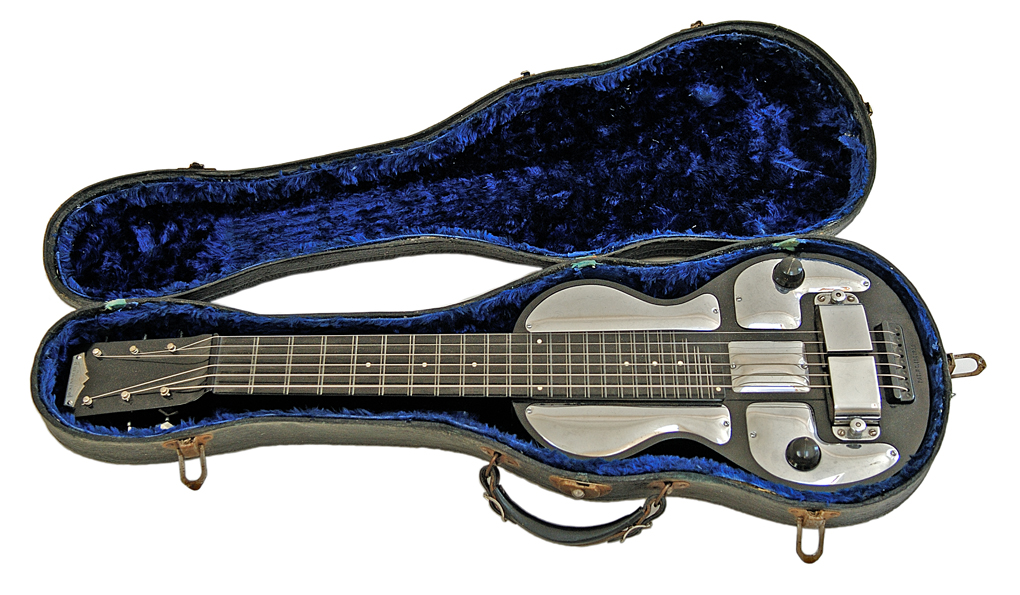
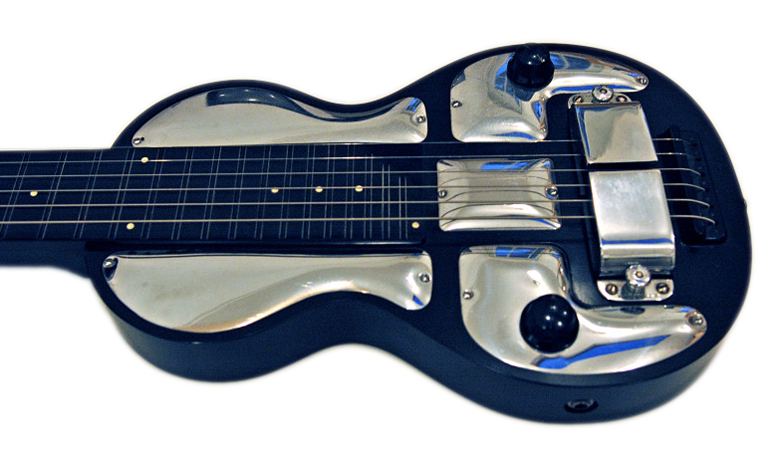
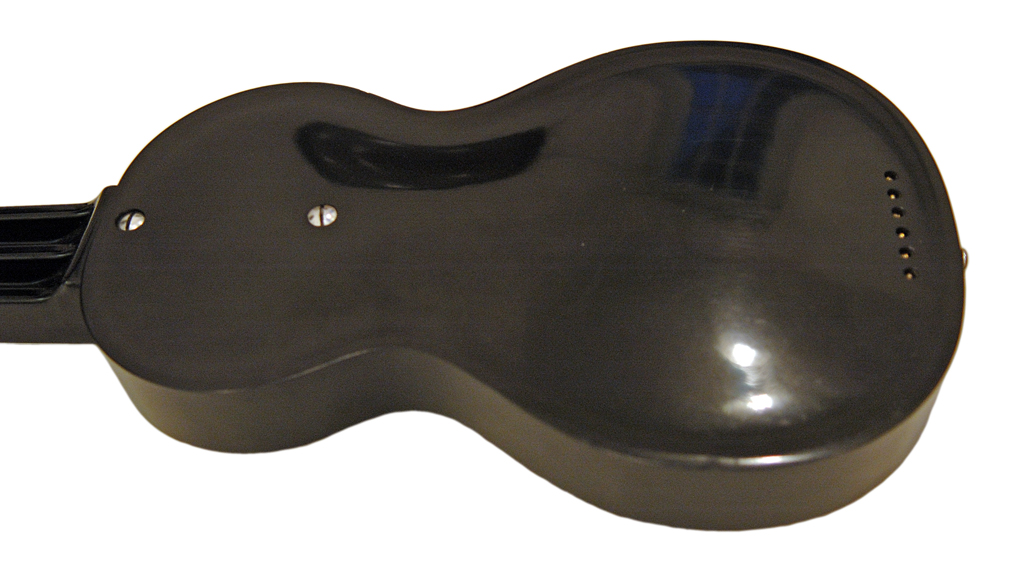
Rickenbacher Electro Model B Lap Steel
Pre-war bakelite steel with two "concentric" knobs on same side, and white painted plates. White plastic tuner buttons.
No serial number.
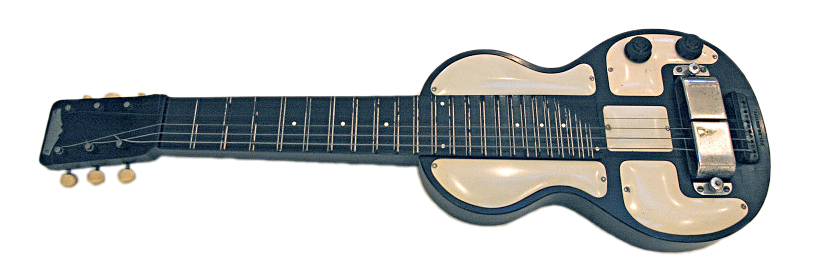
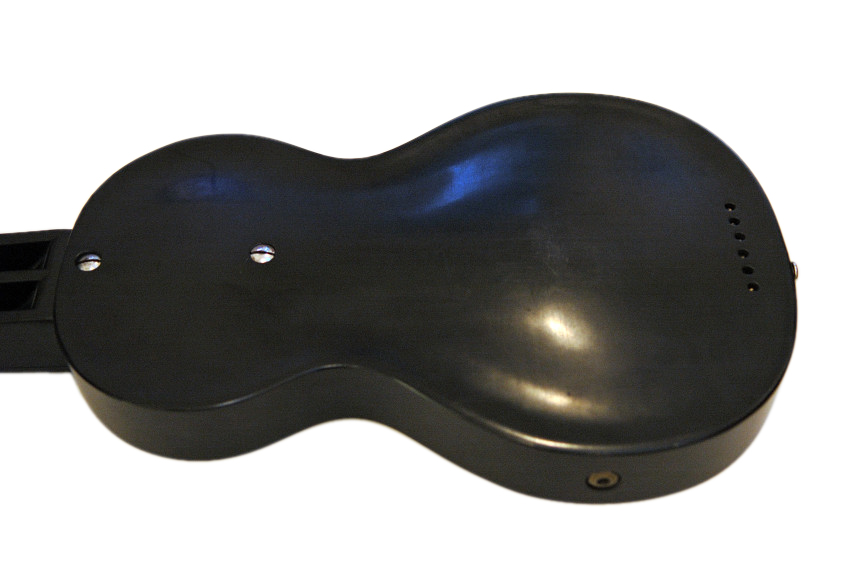
Rickenbacher Electro Model B Lap Steel
Some examples of the model B from later in the 1930's were made with white plastic plates.
Pre-war bakelite steel with two "concentric" knobs on same side, and white plastic plates.
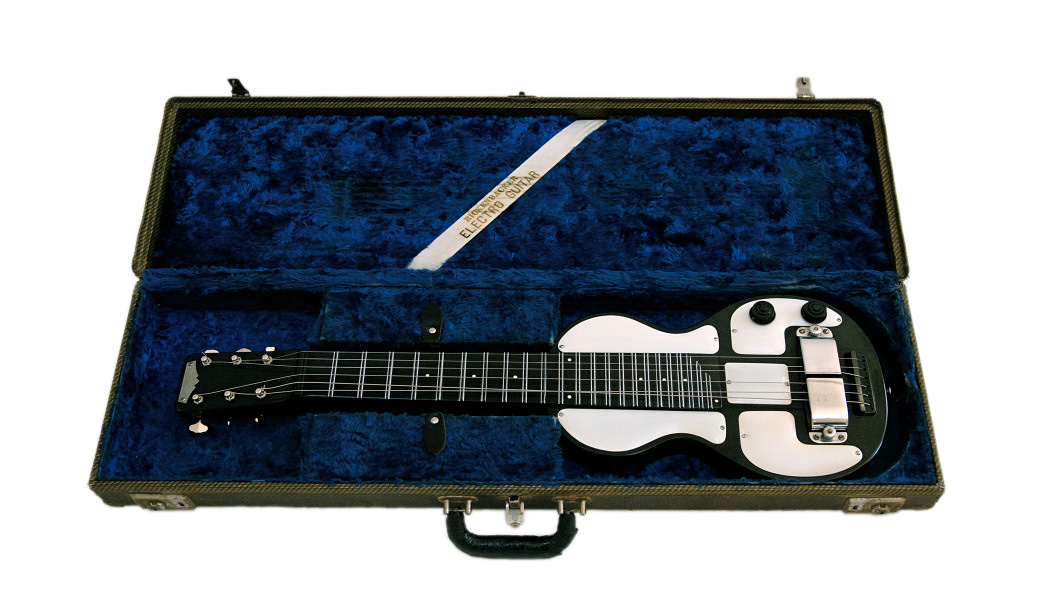
The pre-war version of the model B is distinguished by many features which are now associated with the instruments Leo Fender developed in the 1950's.
Leo Fender's "Fender Radio Service" repair shop, founded in 1938, repaired many amplifiers manufactured by Rickenbacher, while his partner, "Doc" Kauffman was employed by Rickenbacher when he invented the "Vib-Rola" vibrato, so Leo was certainly familiar with Rickenbacher's instruments.
The bolt-on neck, strings that go through the body, and even the curve of the headstock as it approaches the nut, are all features Fender borrowed from Rickenbacher:
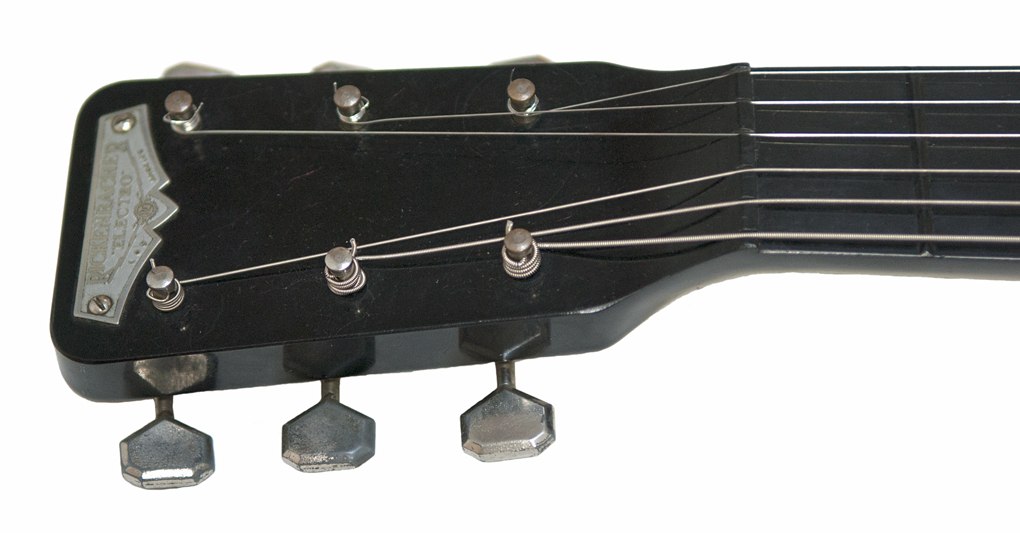

Rickenbacher Bakelite Spanish Electric Guitars
Rickenbacher Electro Model B Spanish Guitar
Rickenbacher also made a round neck version the the model B which is arguably the first solid body electric guitar made for standard "Spanish" style playing.
The round neck version had Bakelite frets that were integral to the neck. Unfortunately, these frets wore ealisy, and could not be replaced. It was expected that the entire bolt on neck would be replaced when the frets wore. The thinner, round neck was also more prone to warping, so it is not easy to find an example today with both good frets and a straight neck when a Spanish Model B in any condition is extremely rare and difficult to find.
Rickenbacher Electro Model B Spanish Guitar
Pre-war bakelite round neck "Spanish Guitar" with two "hexagonal" knobs on opposite sides, and chrome plates.
No serial number.
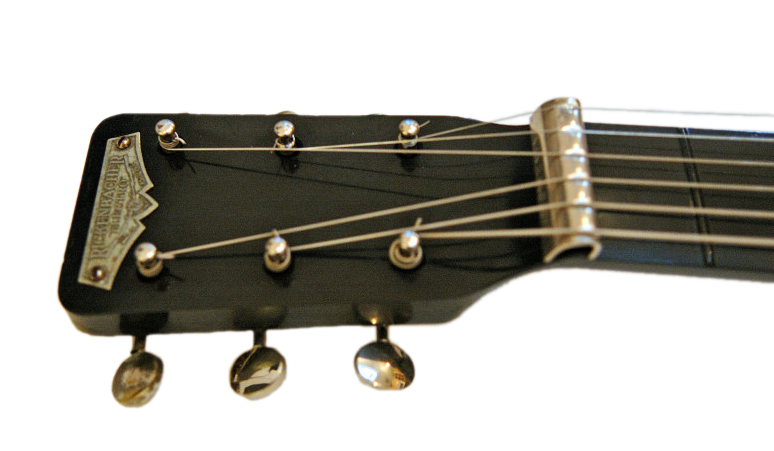
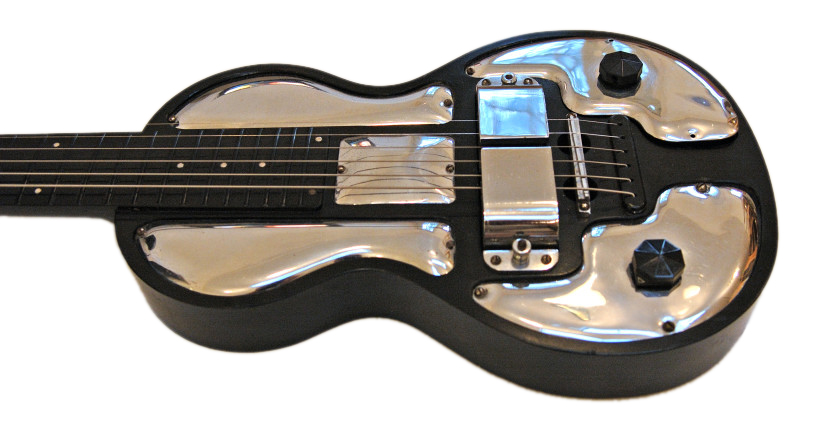
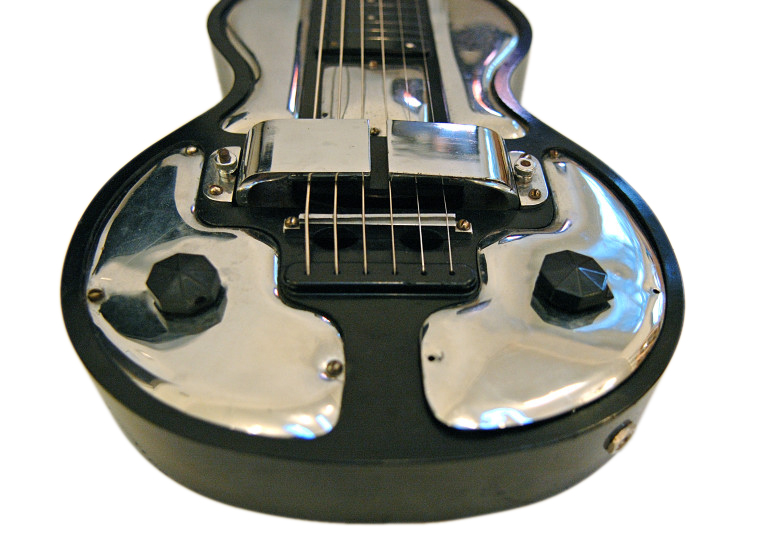
Rickenbacher Electro Model B Spanish Guitar
Pre-war bakelite round neck "Spanish Guitar" with one "hexagonal" knob, and chrome plates. Unusual early example with only four chrome plates. and without the cavity in the body usually covered by a center plate. Certainly one of the very first production solid body electric guitars in existence.
Serial number B36.

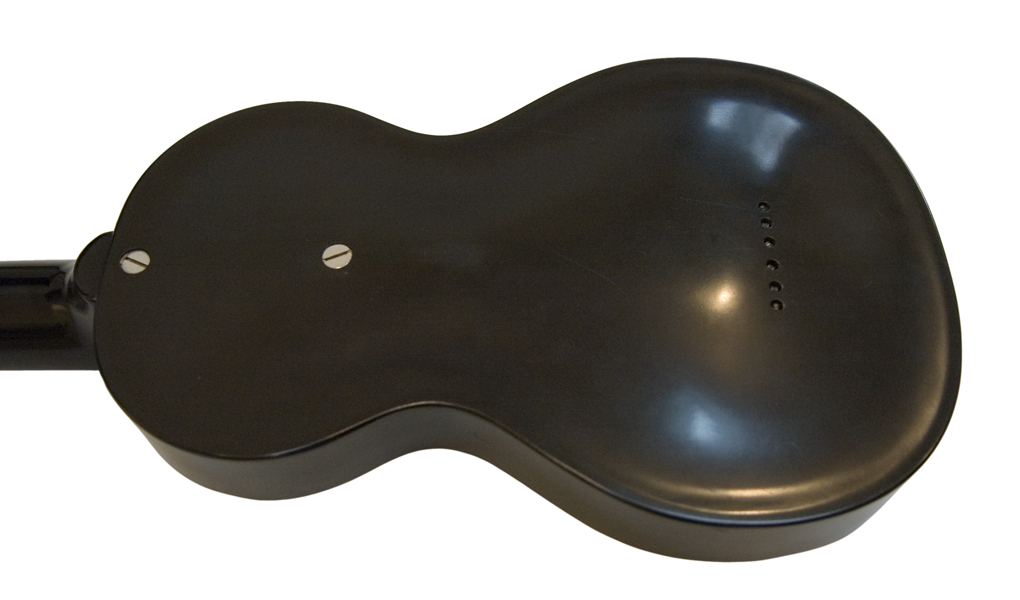
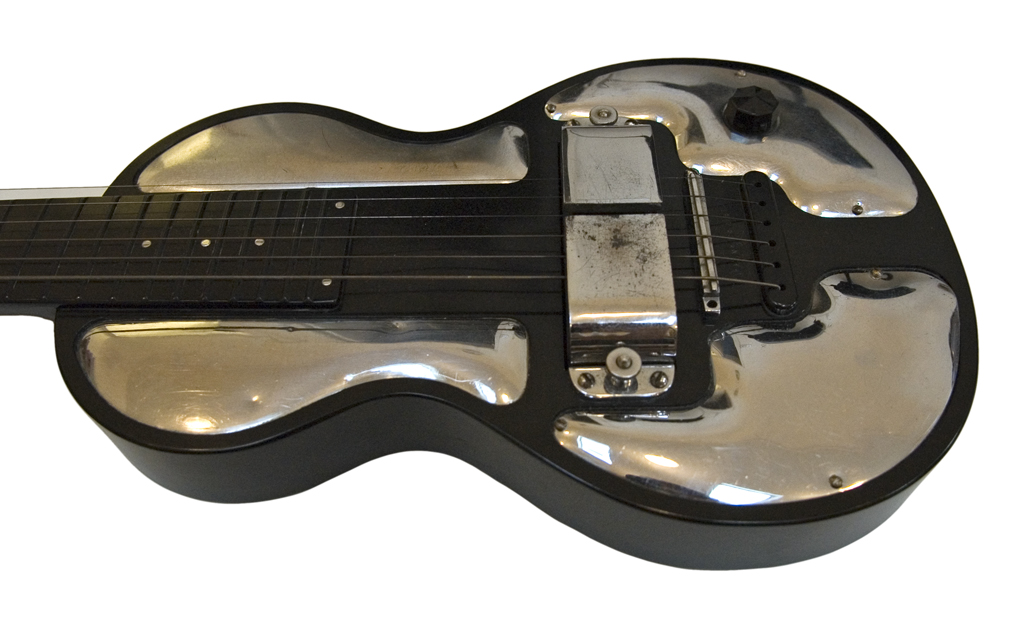
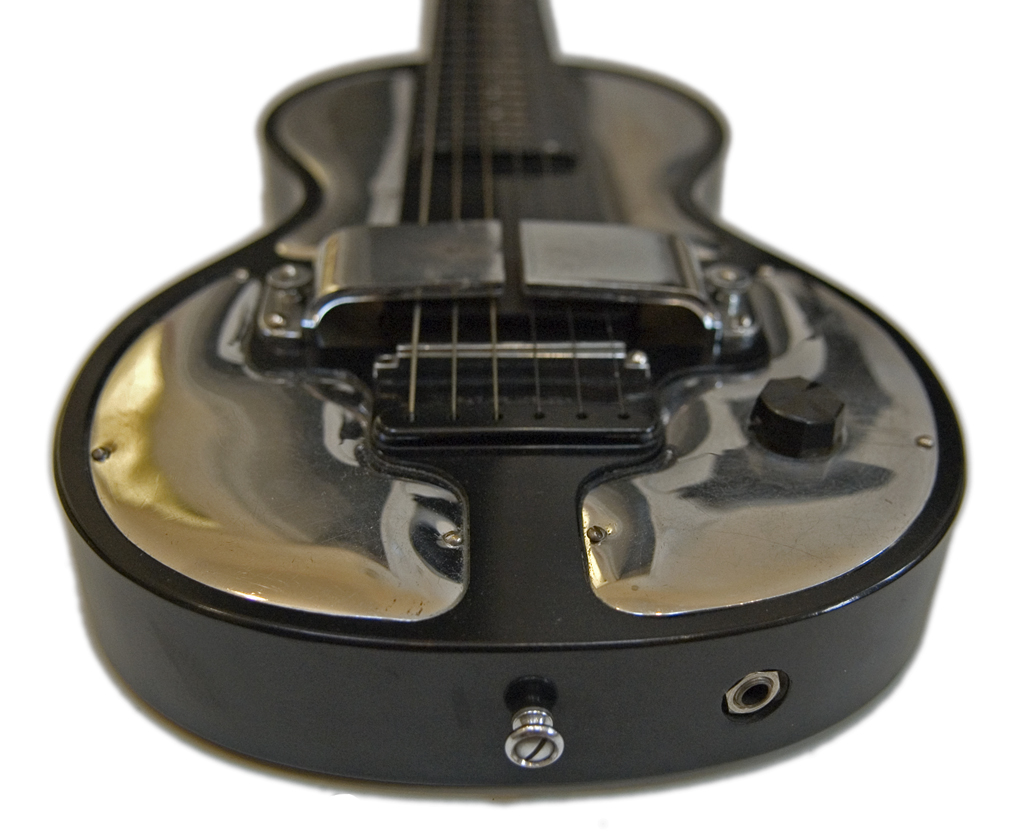
Rickenbacher 1930's Model B Tenor Electro Spanish Guitar
Black Bakelite body, with wooden neck and conventional frets. 1 1/2 inch "horseshoe" magnet pickup.
Five chrome plates. Kauffman vibrato. One bakelite knob on lower bout.
Extremely rare tenor version of the early and rare "Spanish" round neck Bakelite Rickenbacher,
the first production solid body electric guitar, first made in 1935. Made in the one knob version through 1937.
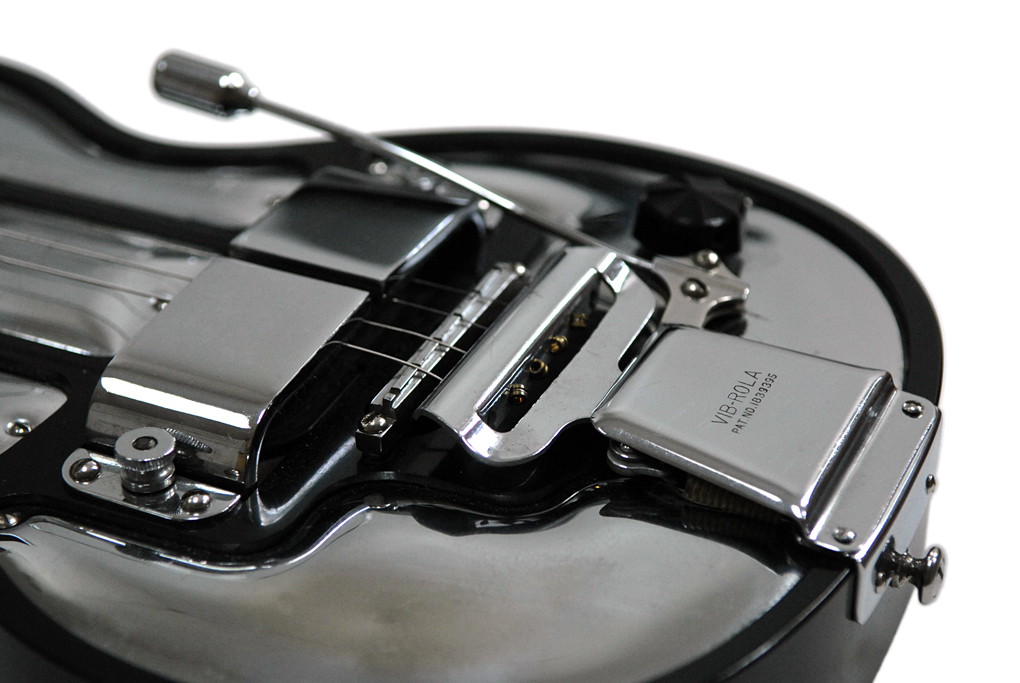

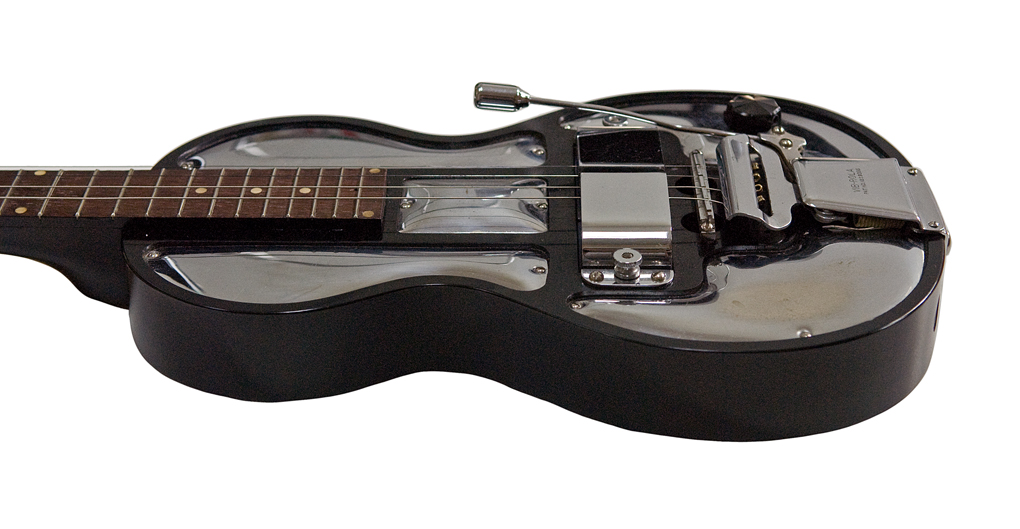
The "Vib-Rola" was invented by Doc Kauffman, who would later join ranks with Leo Fender to start the K&F Co., the precursor to the Fender Musical Instrument Company.
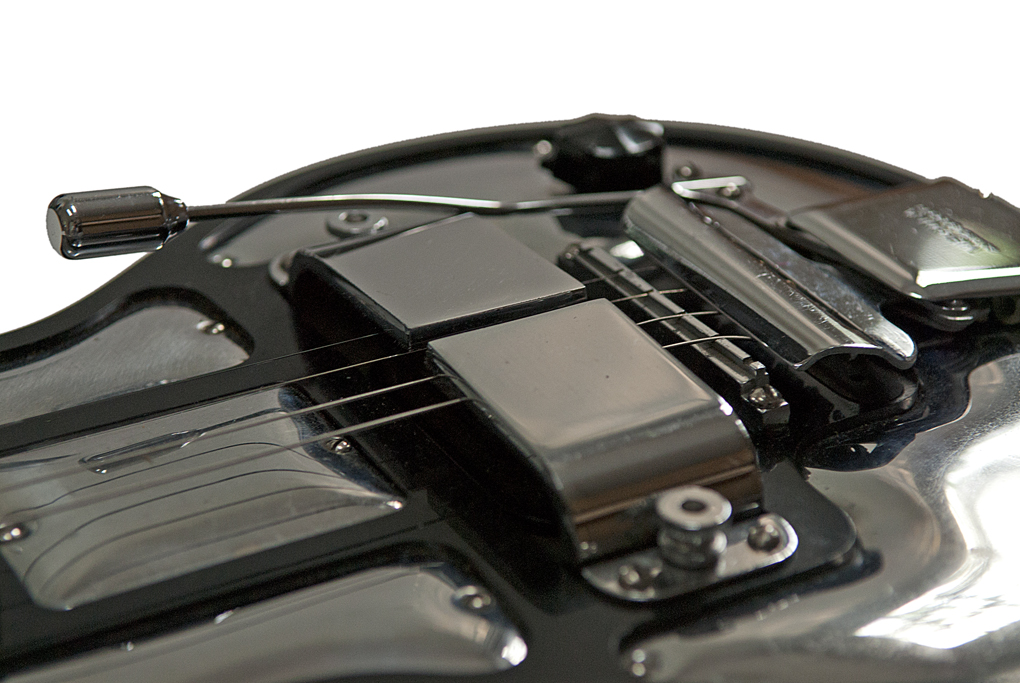
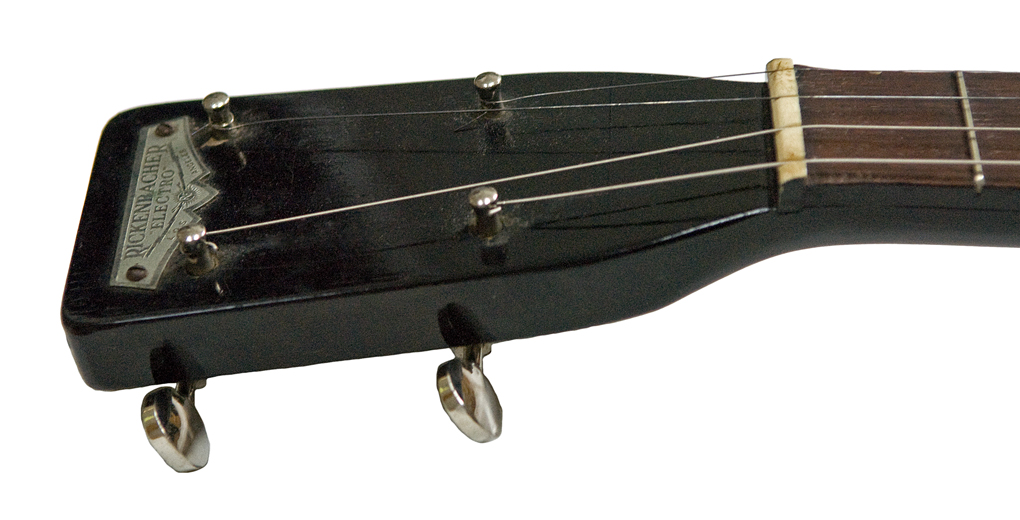
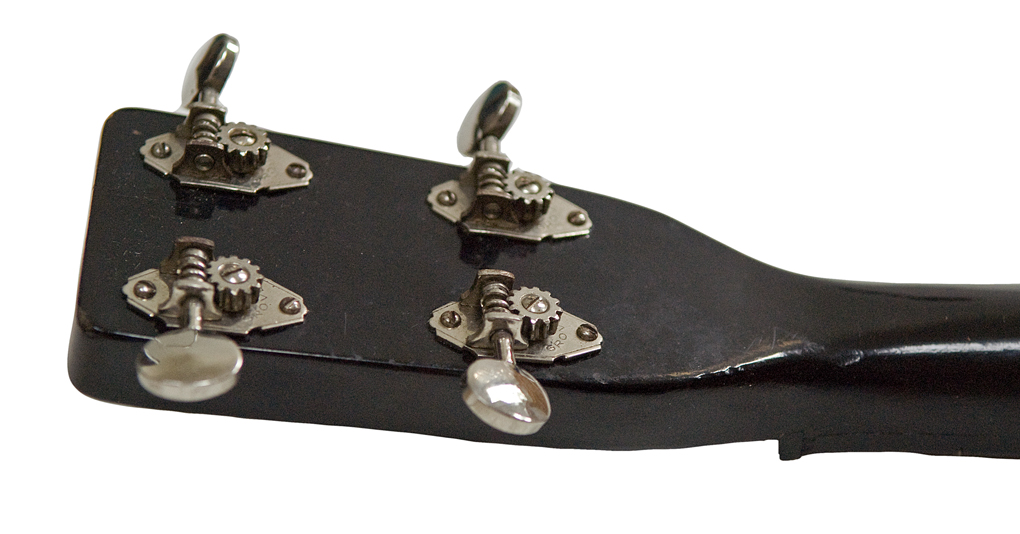

Rickenbacker Spanish Model B with Vibrola.
This is a six string version of the Spanish Bakelite Rickenbacher with Kauffman Vib-Rola.
8 lb. 3.4 oz.
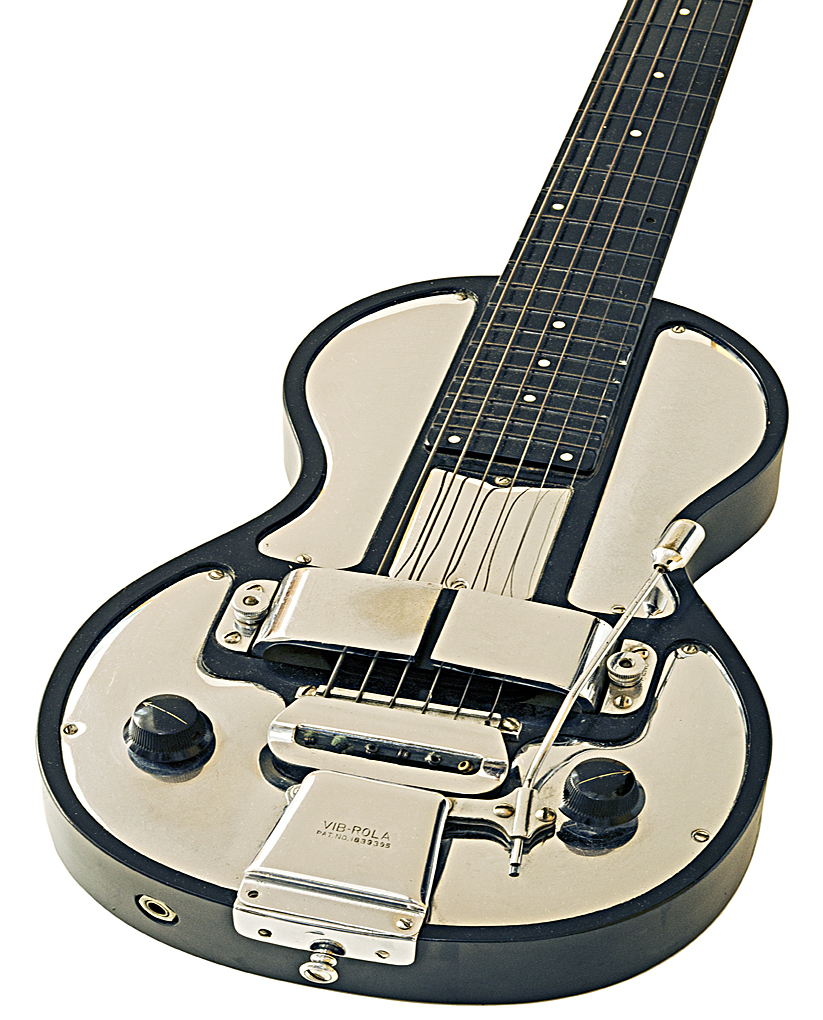
Gold Plated Rickenbacker Spanish Model B with Vib-Rola
This unique example must have been custom ordered by a discriminating customer to have gold plating on the metal plates on the face of the guitar.
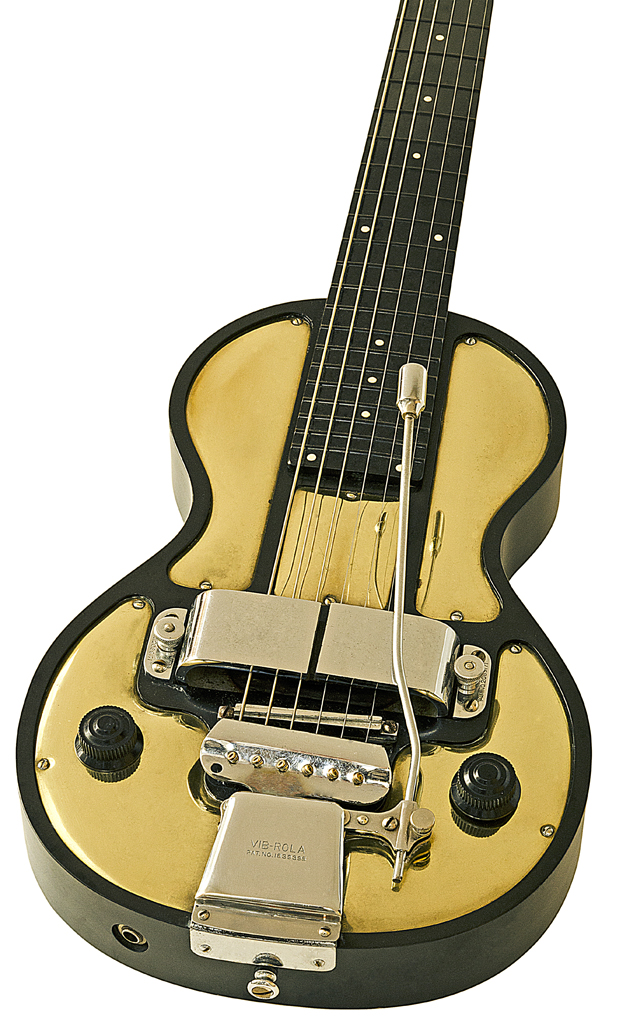

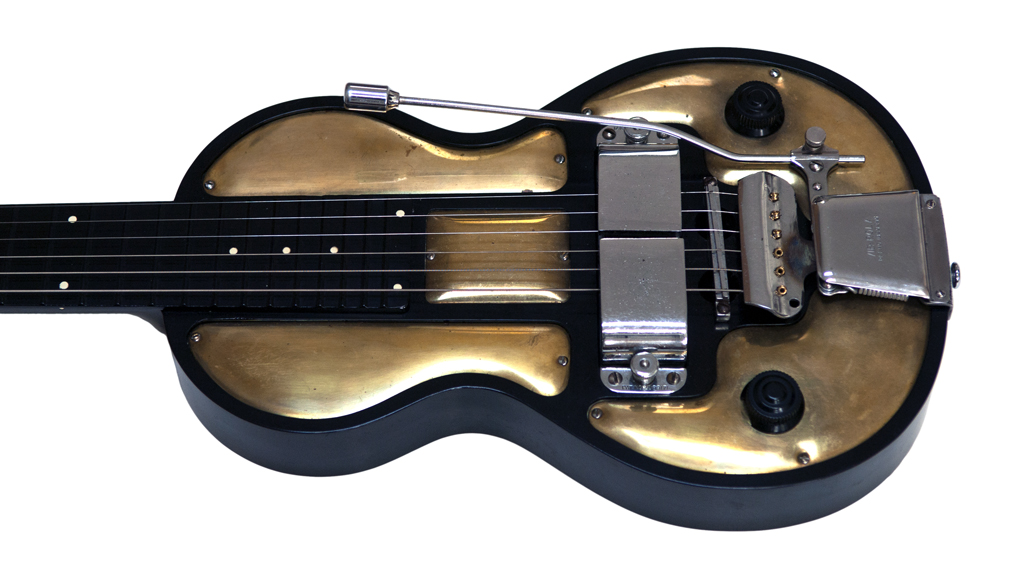

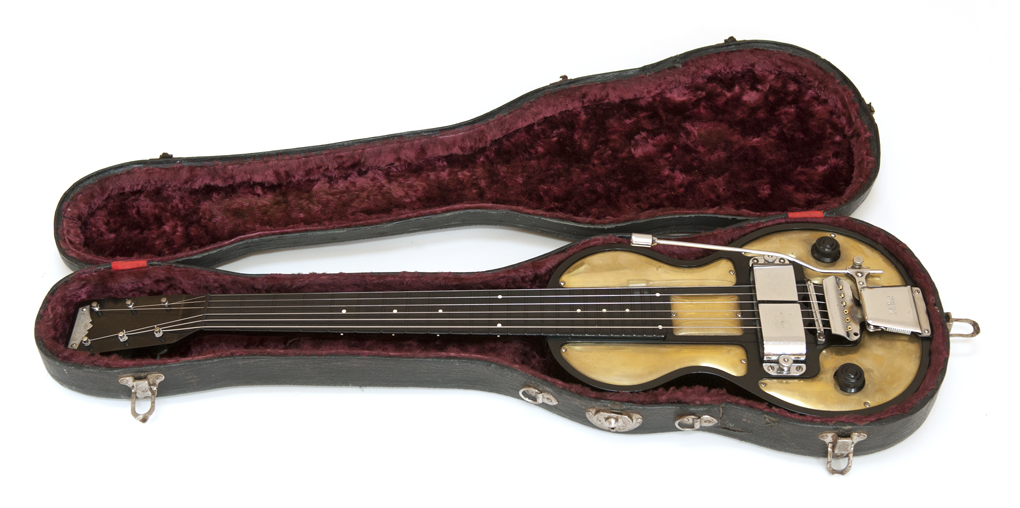

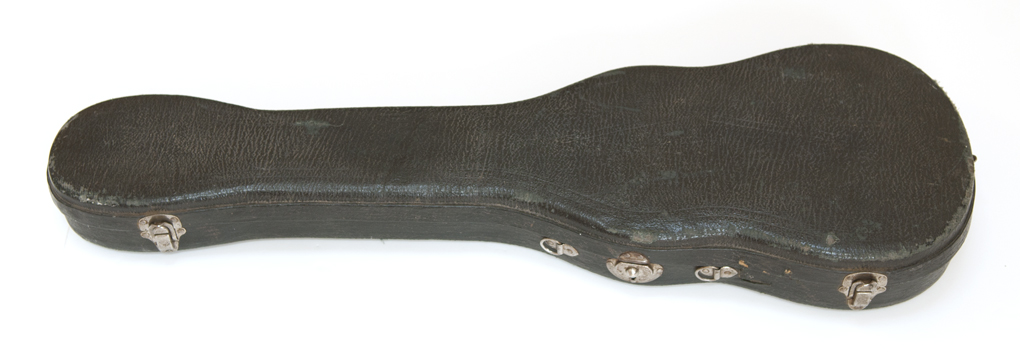
Rickenbacher Electro Spanish Model B Vibrola Guitar
This model had a double thick body which contained a motor which pulled on the strings to give a vibrato effect. This design was also an invention of Doc Kauffman.
Rickenbacher Electro Spanish Model B Vibrola Guitar
Working Kauffman Motorized Vibrola Tailpiece
22 5/8" scale
c 1939
11lb. 2.6 oz.
Serial number C2733
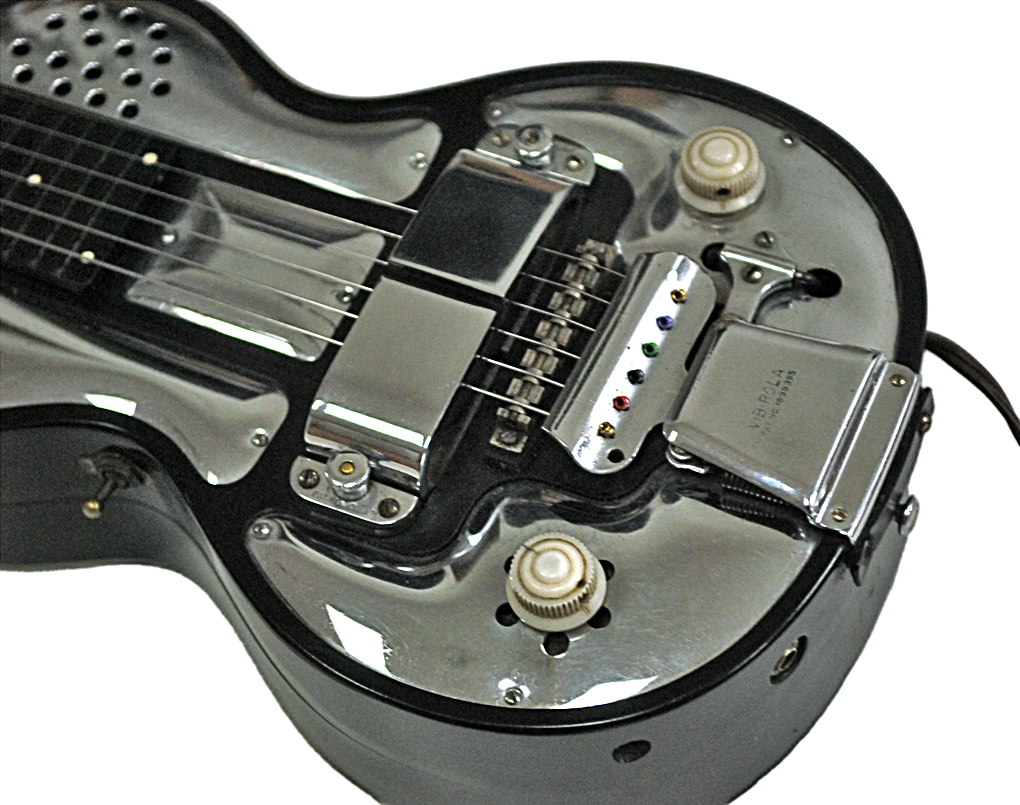
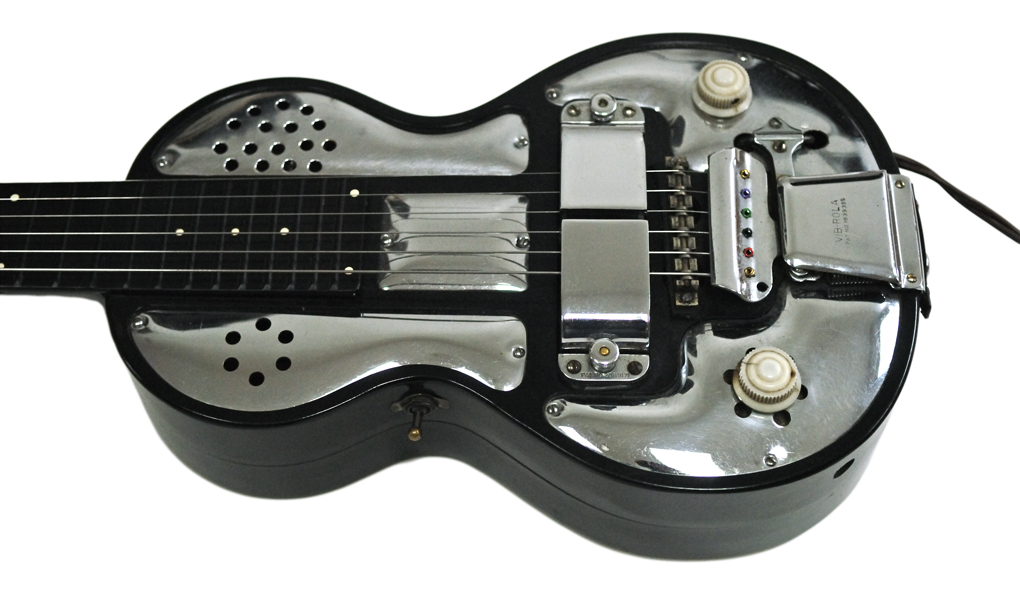


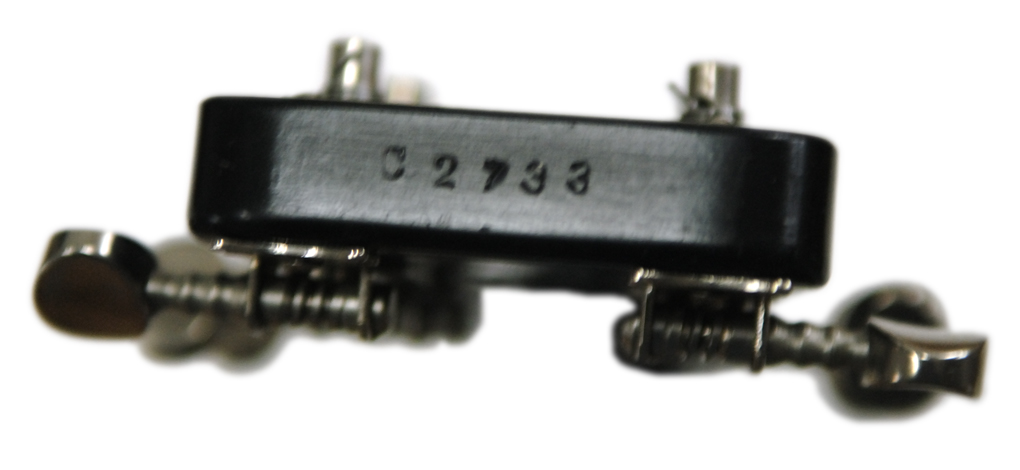
1930's Rickenbacher Violin
In addition to guitars, Rickenbacher produced solid body Bakelite stringed instruments in the 1930's
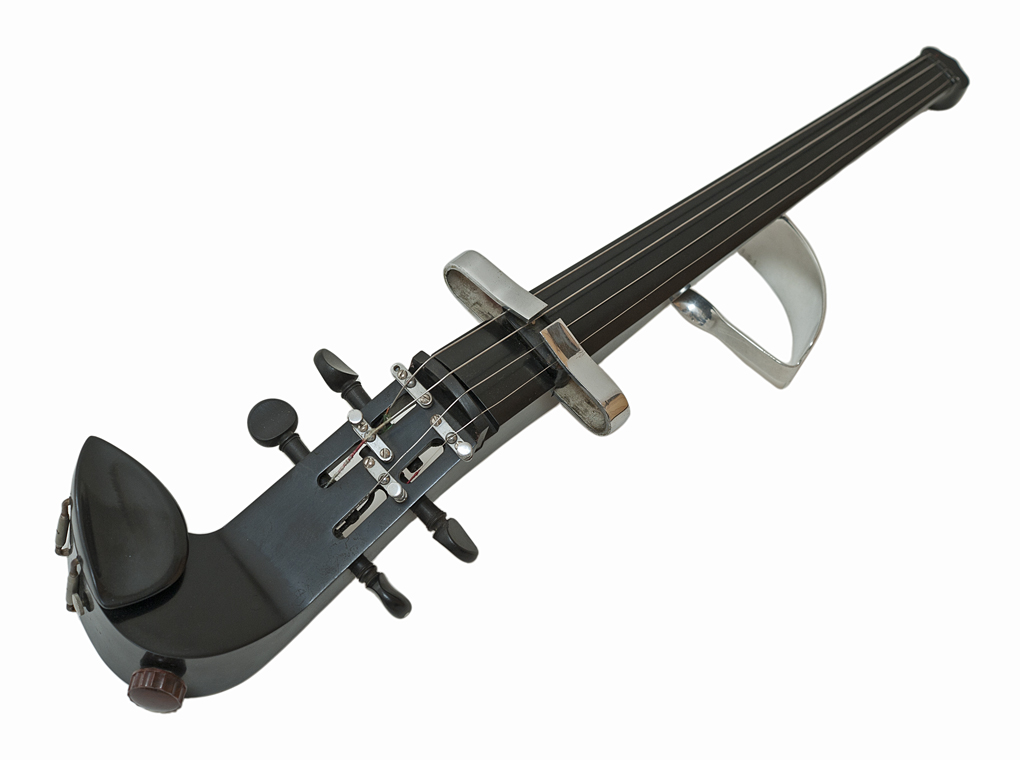
1955 Rickenbacker Combo 800 Guitar
The earliest standard solid body guitar produced by Rickenbacker included a double coil "humbucker" style version of the horseshoe pickup.
The first digit of the serial number represents the model "800", the "C" stands for "Combo", the "5" indicates the year, "1955", and the final two digits indicate the real serial number, #62, for the 62nd guitar of this style.
Serial Number 8C562
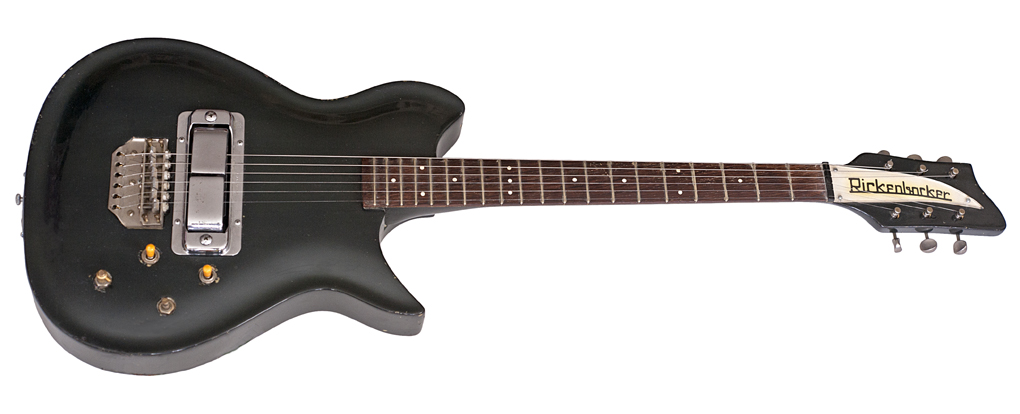
1957 Rickenbacker Combo 400 Guitar
The Combo 800 was soon followed by the "tulip shaped" solid body Rickenbacker Combo 400 which included a single coil pickup.
6 lb. 2 oz.
Serial number 4C7344
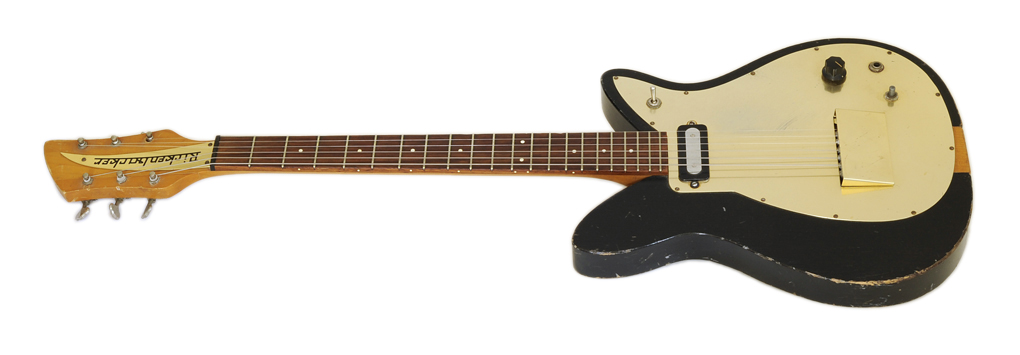
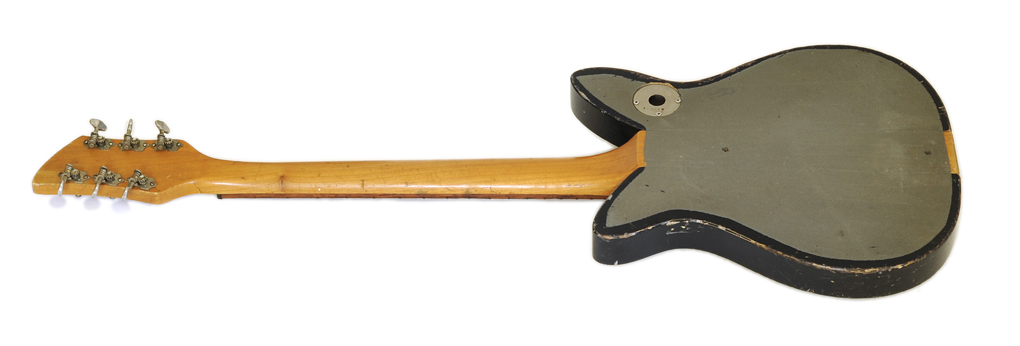
1956 Rickenbacker Combo 400 Guitar
6 lb. 7.6 oz.
Serial number 4C6121
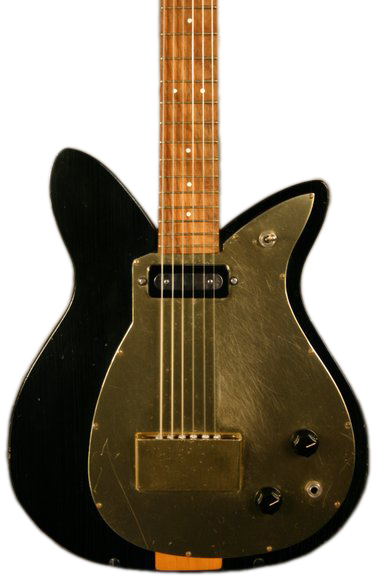
Gibson Lap Steel Guitars and Amplifiers
Like Rickenbacher, Gibson also made their first lap steel guitars with an aluminum body. These guitar had the same style of pickup made famous by Charlie Christian on the arch top guitars he played with the Benny Goodman band.
Gibson E-150 Lap Steel Guitar c 1935
Early version Gibson lap steel with aluminum body and "Charlie Christian" pickup. Original hard shell case.
8 lb. 14.8 oz.
serial number 231


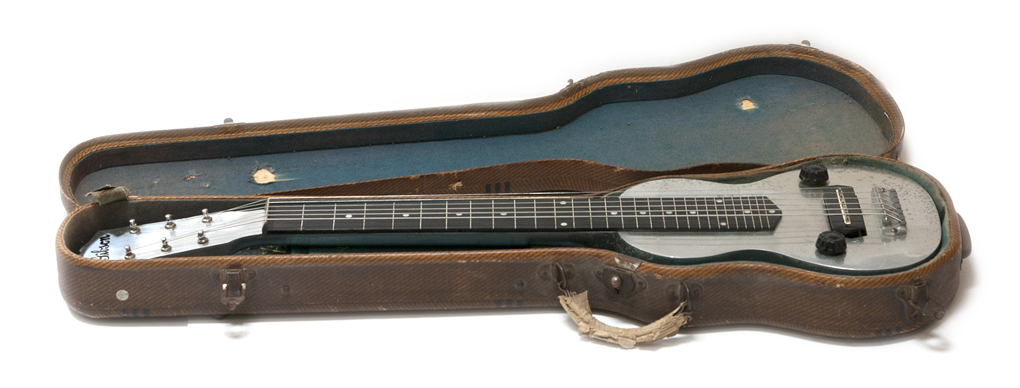

Early Gibson EH-150 Amp
Second Variation of First Version
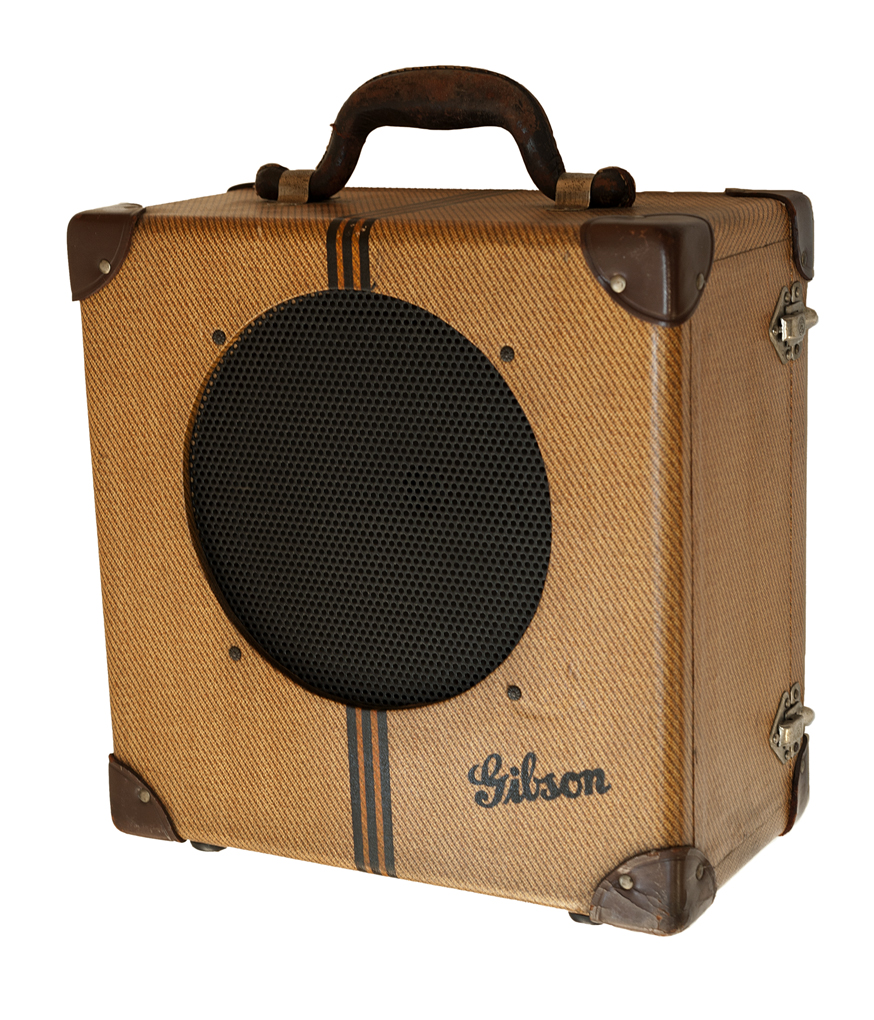
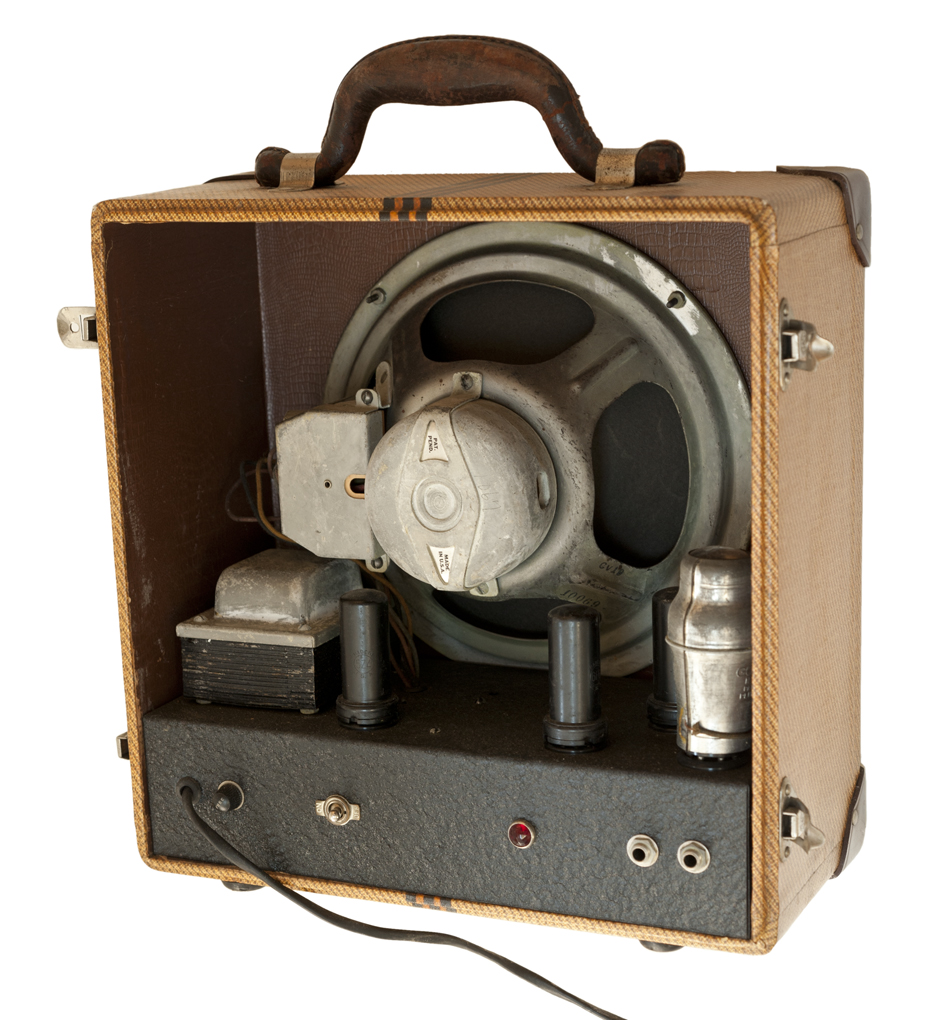
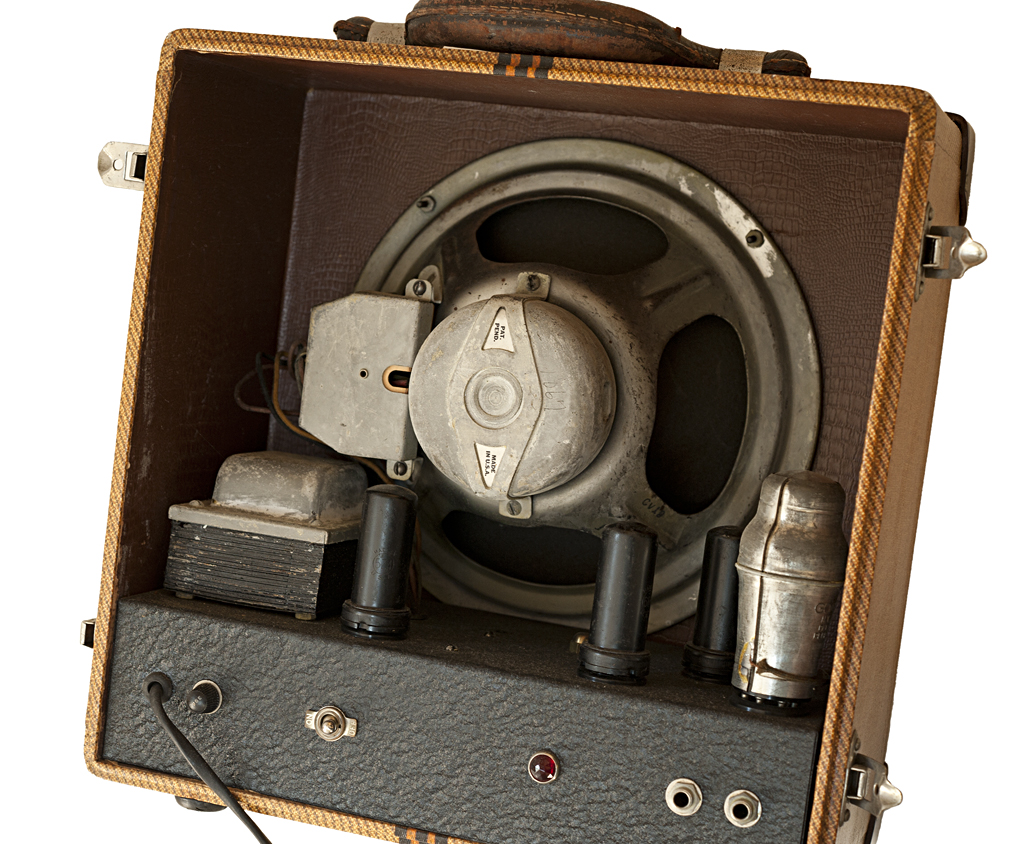
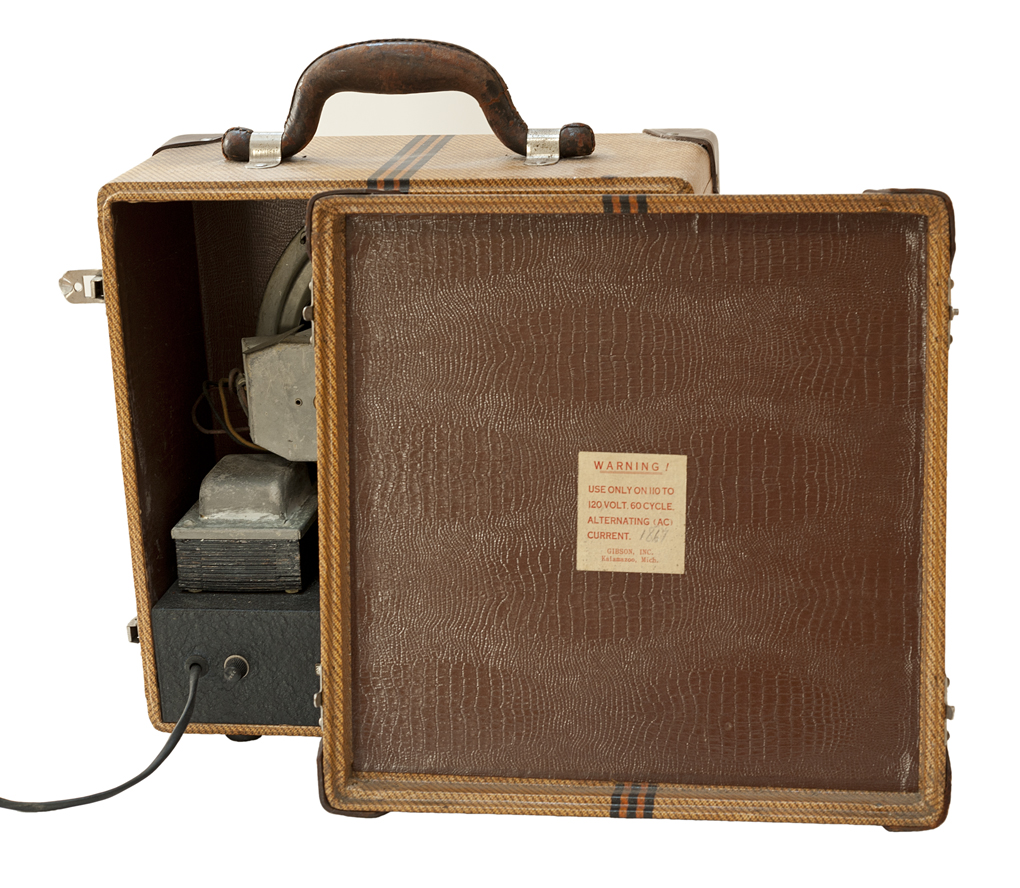
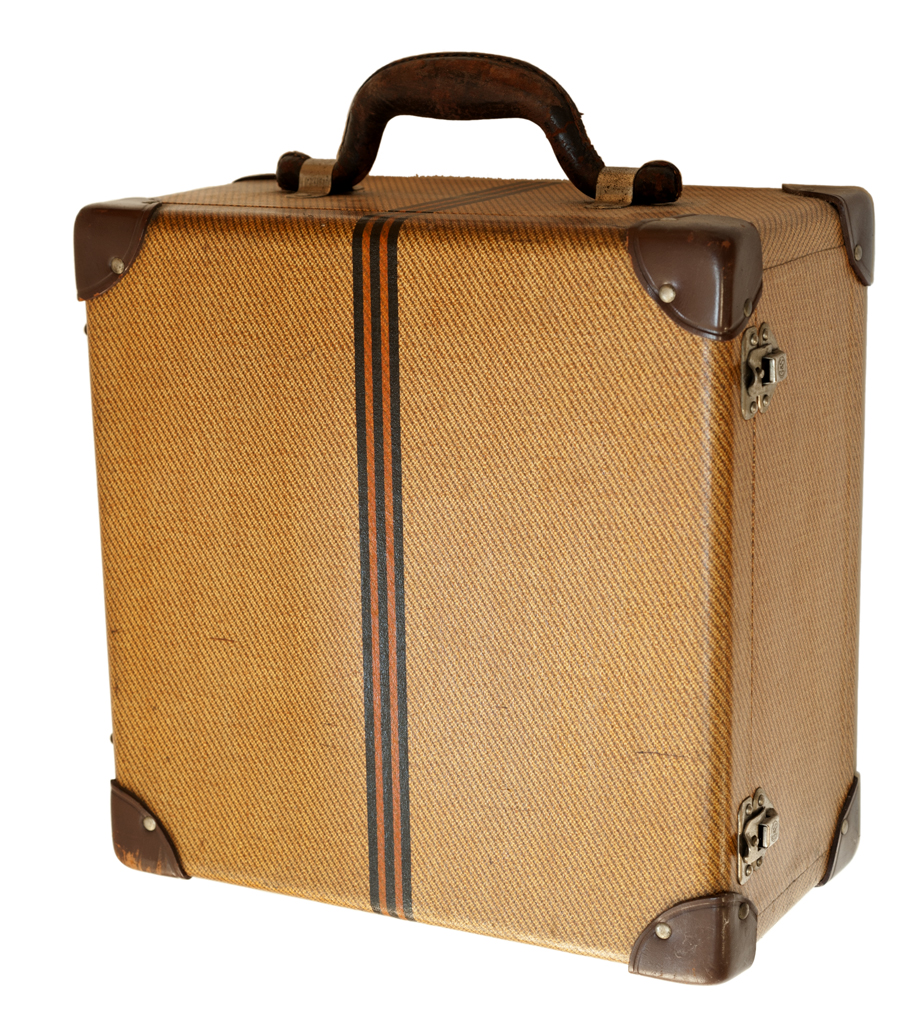
The E-150 soon gave way to the wood body EH-150.
Gibson EH-150 Lap Steel Guitar c 1939
Separate treble pole piece style "Charlie Christian" pickup. Separation or crack on top near bridge. Original hard shell case.
serial number EGE 2644
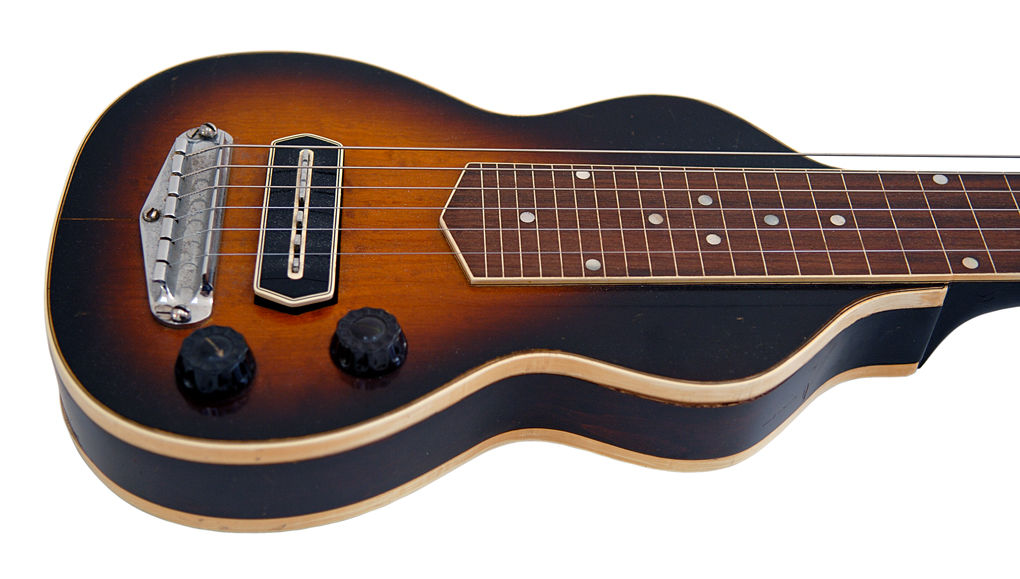


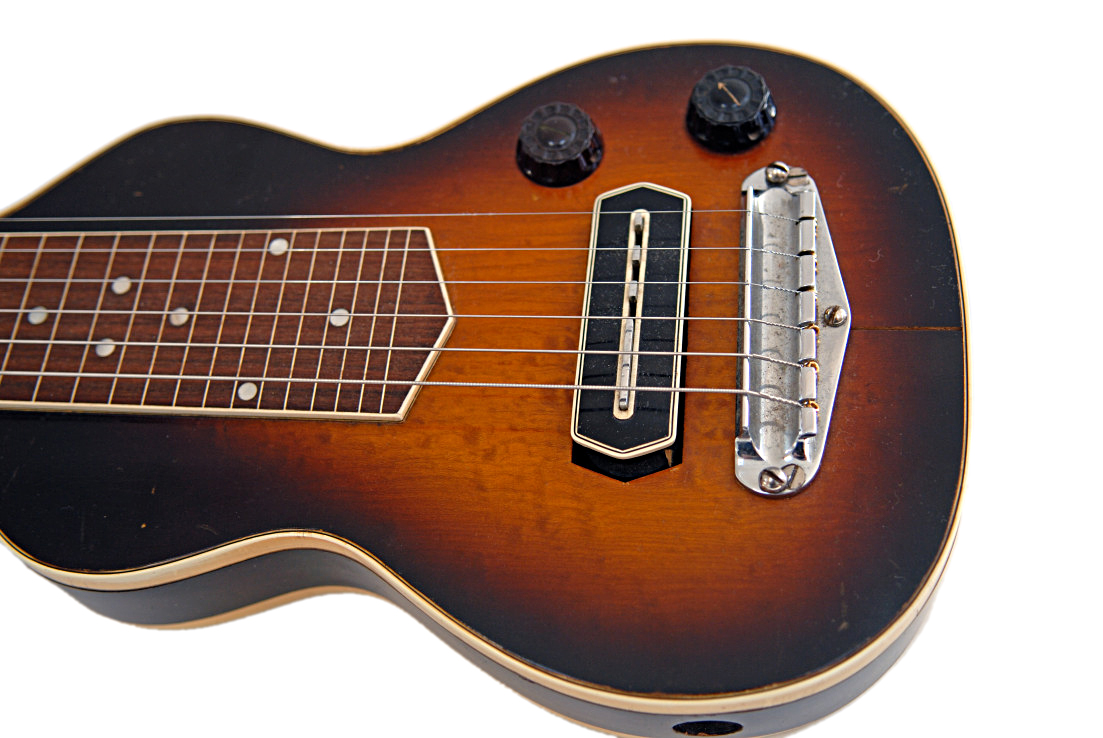
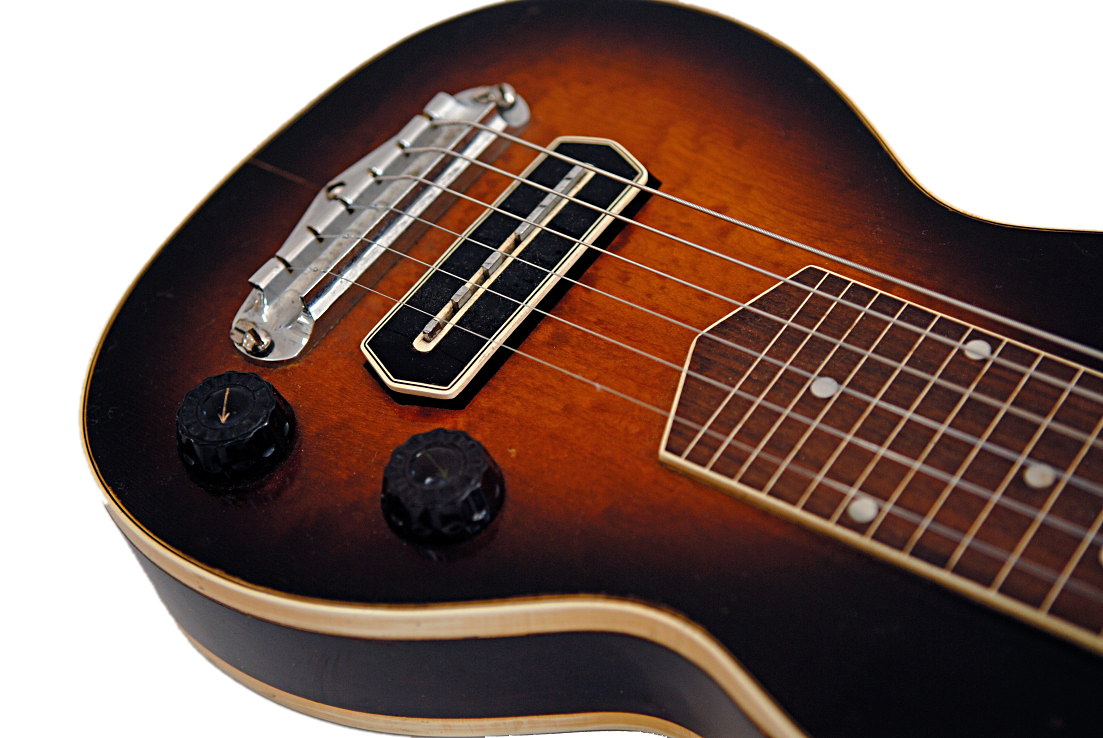

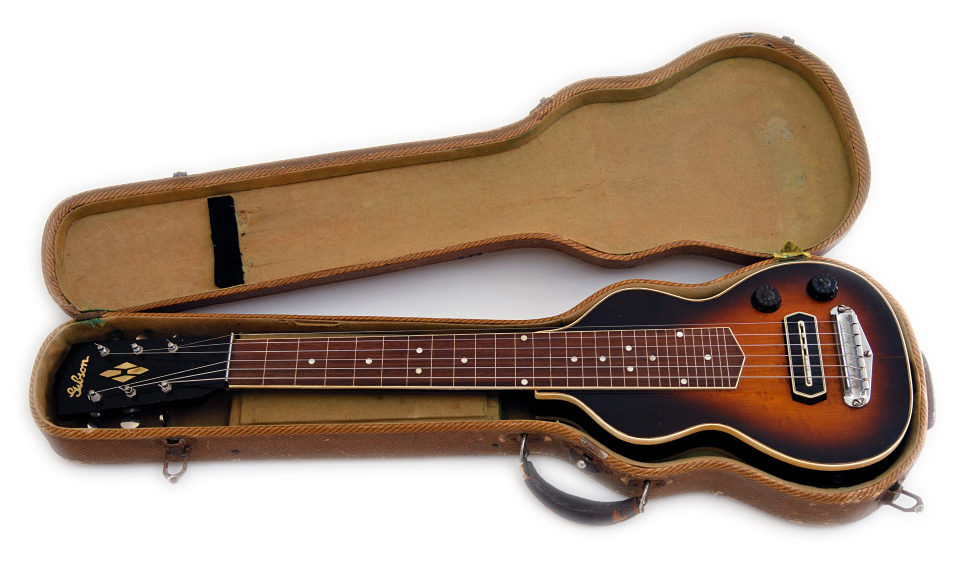
Gibson 1936 Recording King Roy Smeck Lap Steel
5 lb. 6 oz.
Serial Number 244-17
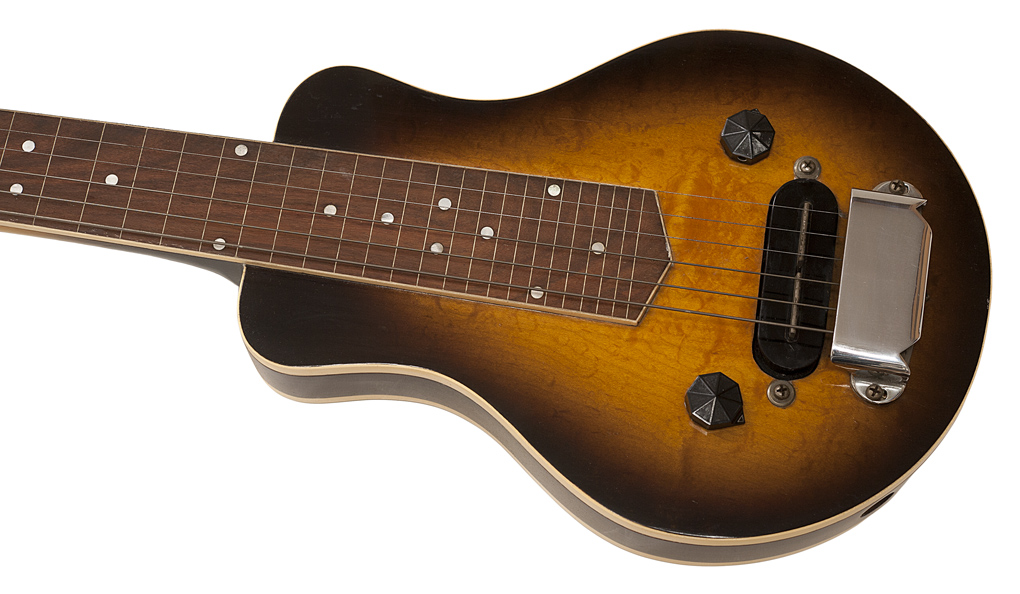
The early Roy Smeck Recording King Lap Steel was made in a number of different models, some of which had a pear shaped body, without "shoulders". Smecks were made with a number of different variations of the peghead shapes found on Gibson "contract" guitars made for other firms, as well as Gibson "Kalamazoos", some of which had the fancy "Crest" Insignia, and some of which were blank and solid black.
6 lb. 3 oz.
Serial number FWE727

Some of the Gibson and Recording King lap steels have "screw-on" backs.

Gibson Ultratone Lap steels
In the 1940's to '60's Gibson produced lap steels with an Art Deco look and striking color schemes.


1960's Ultratone


Gibson Pedal Steel Guitars
1941 Gibson Electraharp Pedal Steel Guitar
The Gibson Electraharp, designed Gibson machinist John Moore and endorser Alvino Rey, was Gibson's first pedal steel guitar, and the first modern pedal steel by any maker to enter the market.
Factory Order Number E4141-1
This example, with the Factory Order Number E4141-1, was the very first pedal steel guitar to be produced by Gibson, the first of a batch of 10 instruments. According to the literature, a total of 13 guitars were made before the war, although a second, larger batch appears in the Shipping Ledgers with the FON 5091. Because of a patent dispute, production was halted until after the war, when the early Electraharp design was replaced by a much less sophisticated and desirable design.
The Electraharp was Gibson's most expensive product, priced at $477, over 30% more than Gibson's fanciest Super 400 arch-top guitar.
This first Electraharp was owned by Gibson endorser George Hines after being shipped to the N.Y. Band Company in September, 1941.
"The first modern, professional quality pedal steel...extremely rare and quite a conversation piece." - Gruhn's Guide to Vintage Guitars.
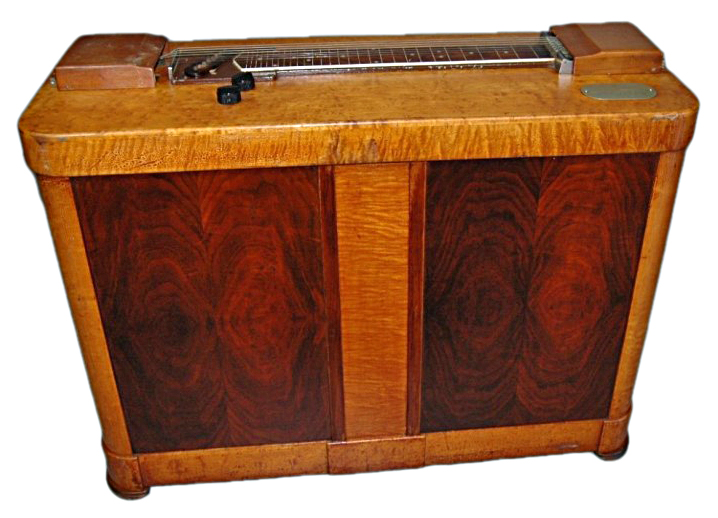
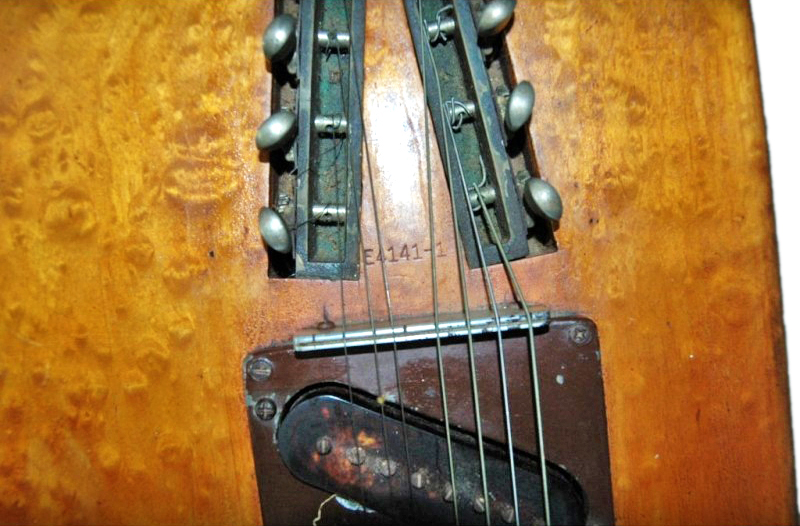
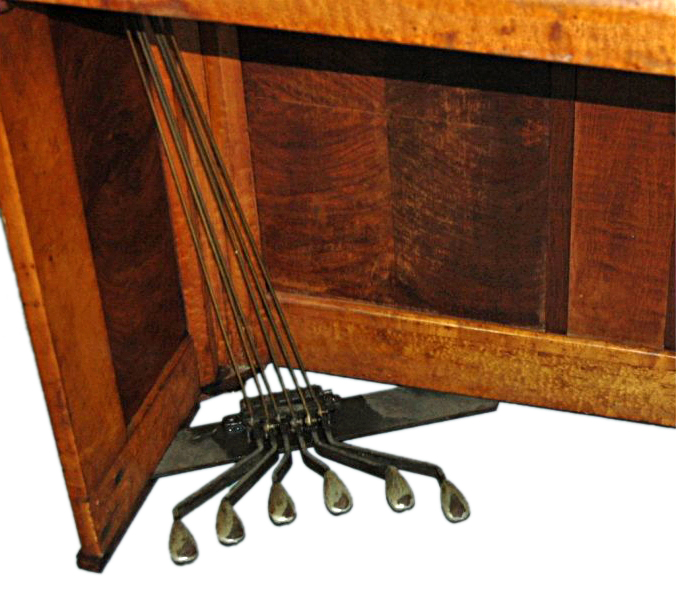
Gibson Archtop Electric Spanish Guitars
Gibson's Electric Spanish is recognized as being the first production conventional guitar with an electric pickup.
1937 Recording King Roy Smeck #1128
Serial Number 342C2
Early model with volume control only, no tone control. The "Recording King" line of guitars was produced by Gibson and a number of other makers to be sold by the Montgomery Ward Stores.
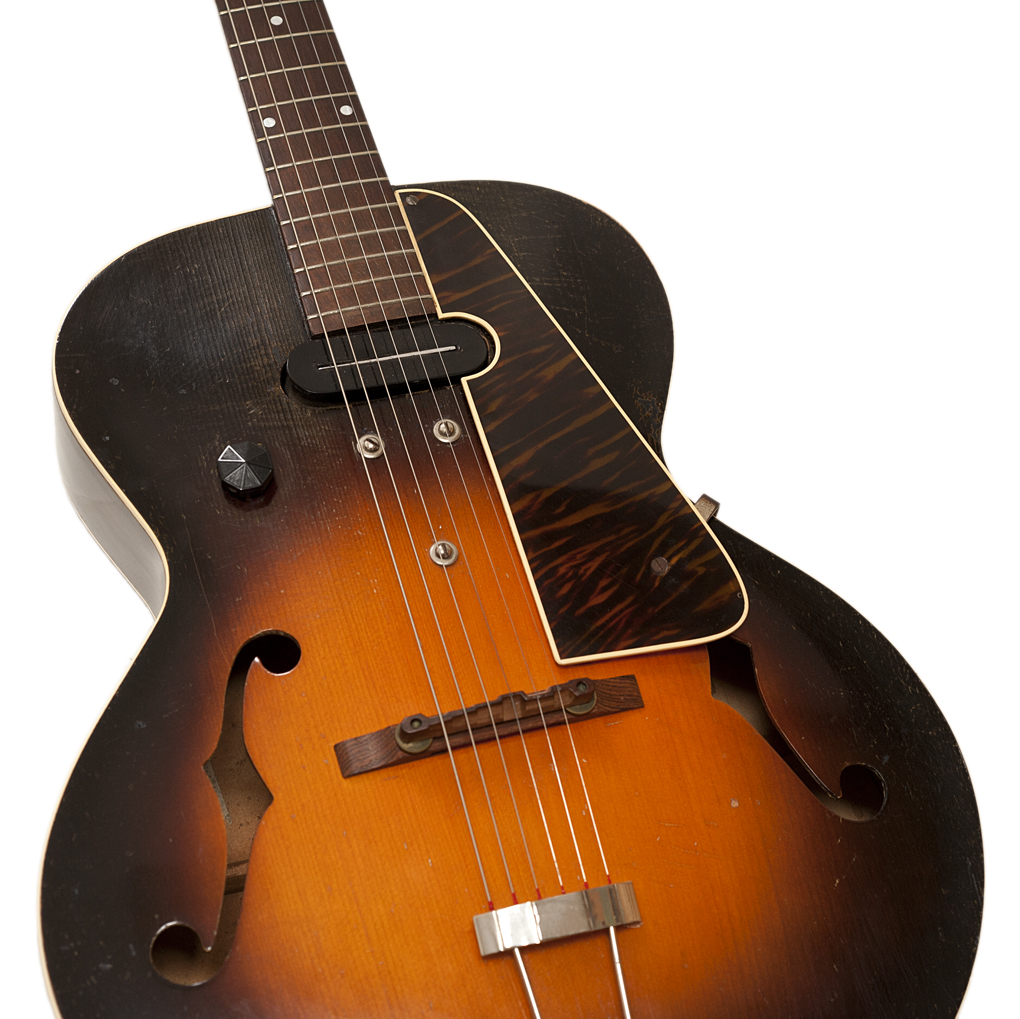
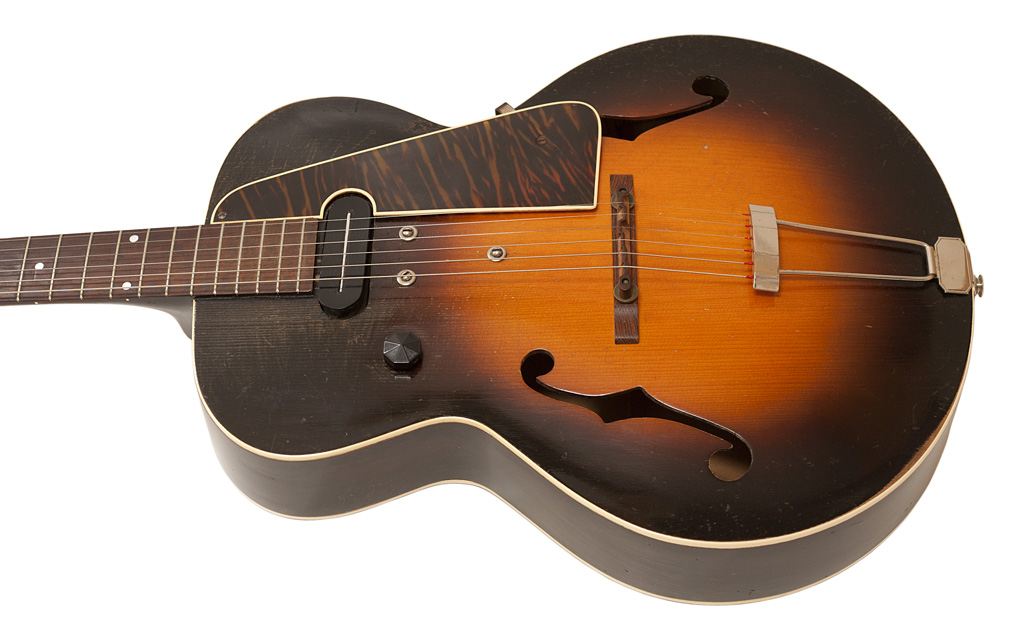
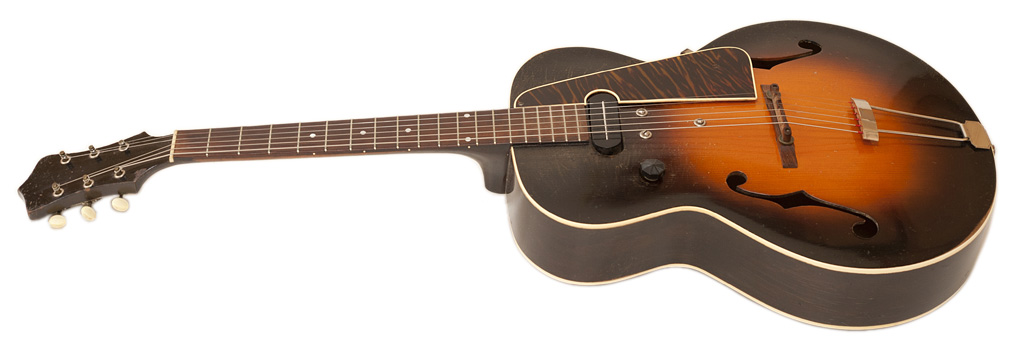
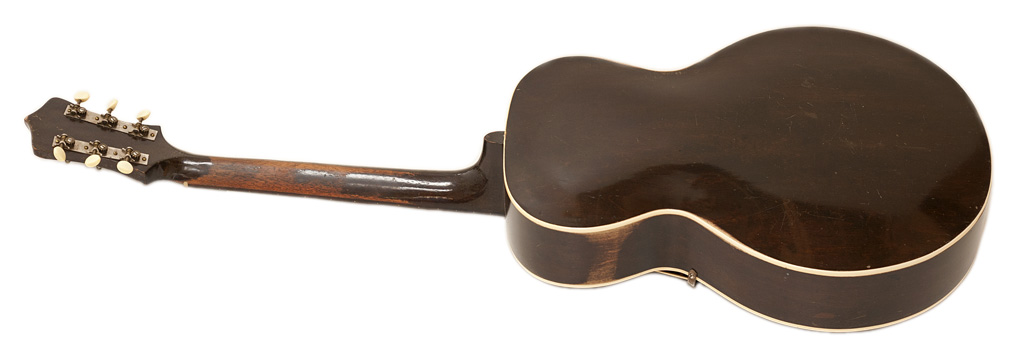
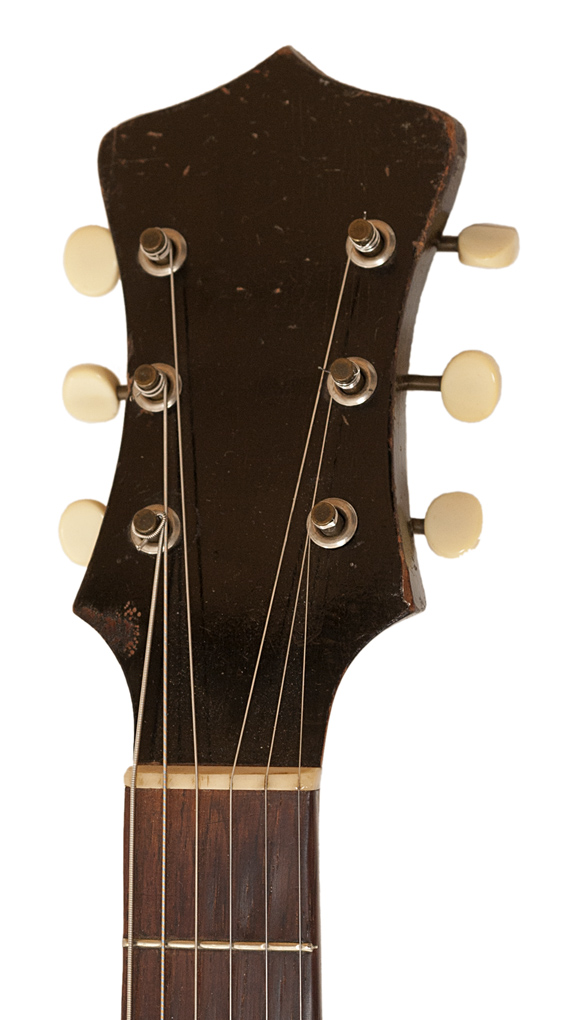
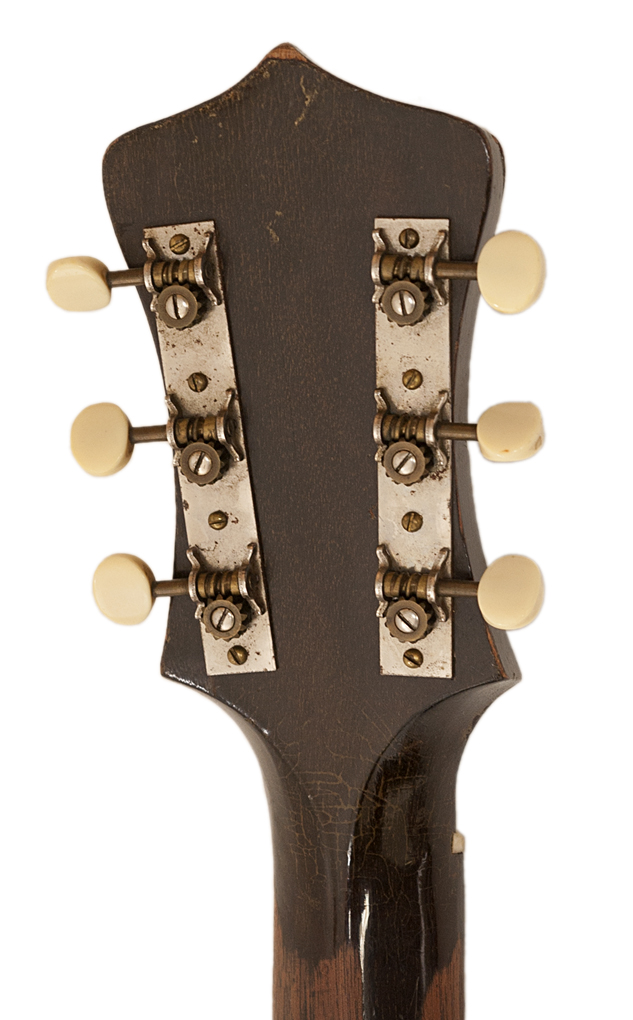
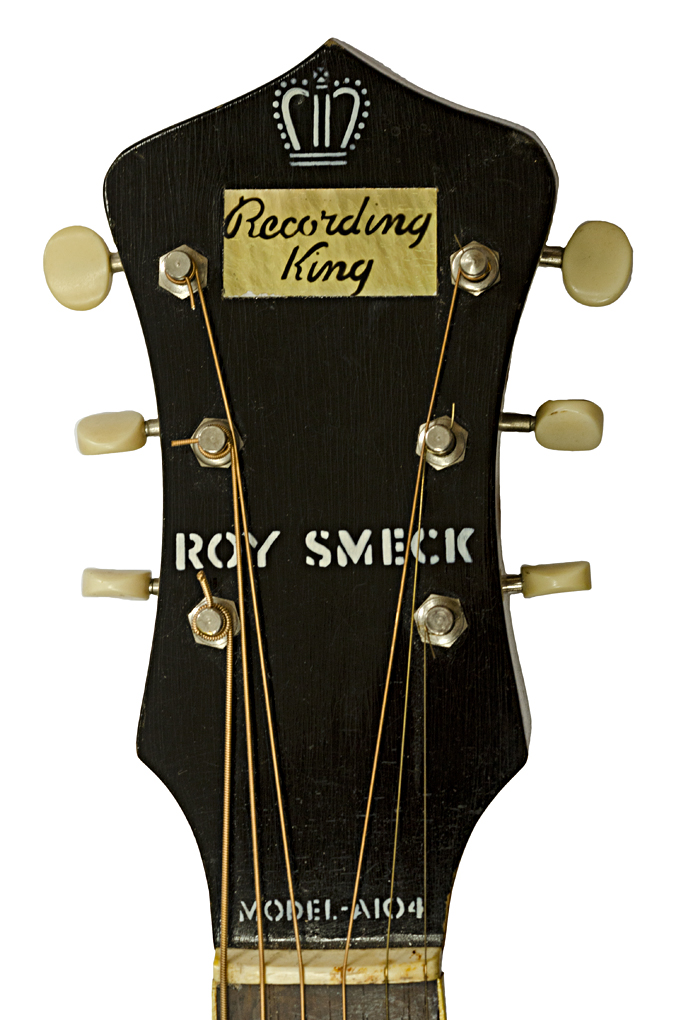
Gibson ES-150
The earliest production Gibson Electric Guitar, the model popularized by Charlie Christian, leading to the pickups being known as "Charlie Christian Pickups".
Serial number DGE 3056
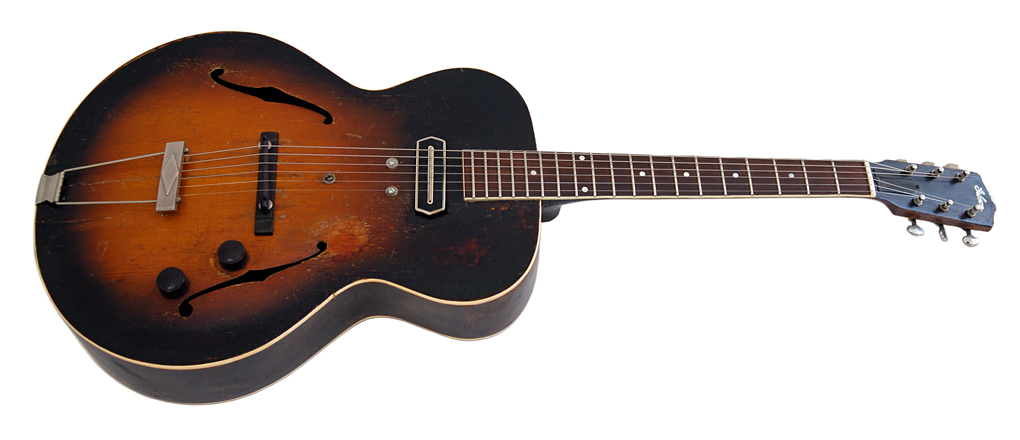
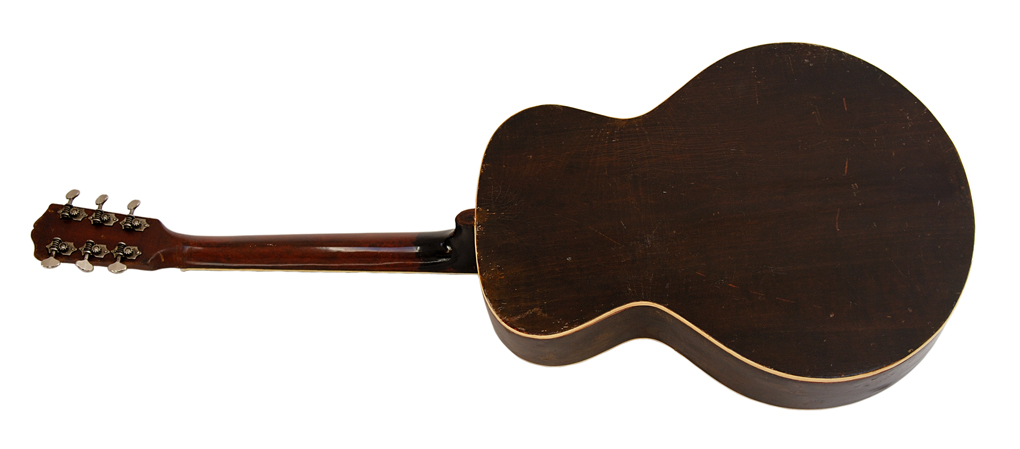
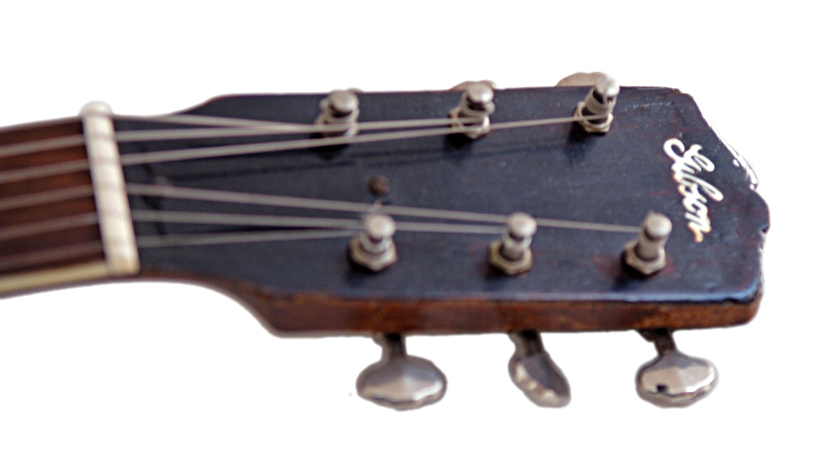
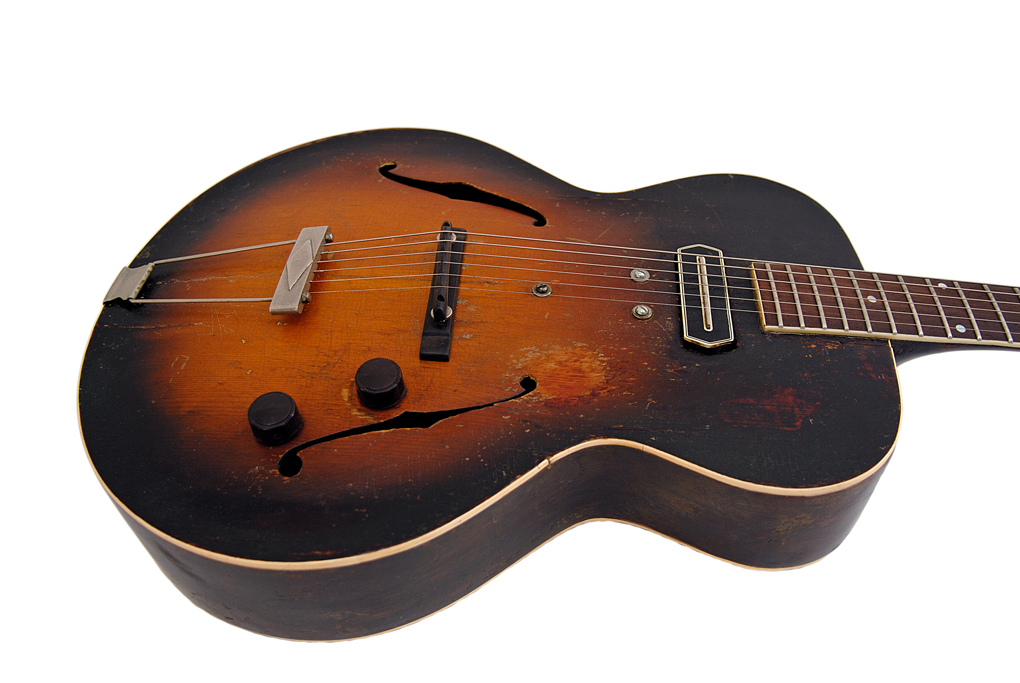
K&F and Fender Lap Steel Guitars
In 1945, "Doc" Kauffman, who had invented the "Vib-Rola" used by Rickenbacher, and Leo Fender, who had been a salesman for Rickenbacher, formed a partnership to manufacture and market lap steel guitars of their own simple and inexpensive design from Leo Fender's home in Fullerton, California.
K&F Lap Steel Guitar
Serial Number 501

This guitar had black fret markers painted onto the fretboard.
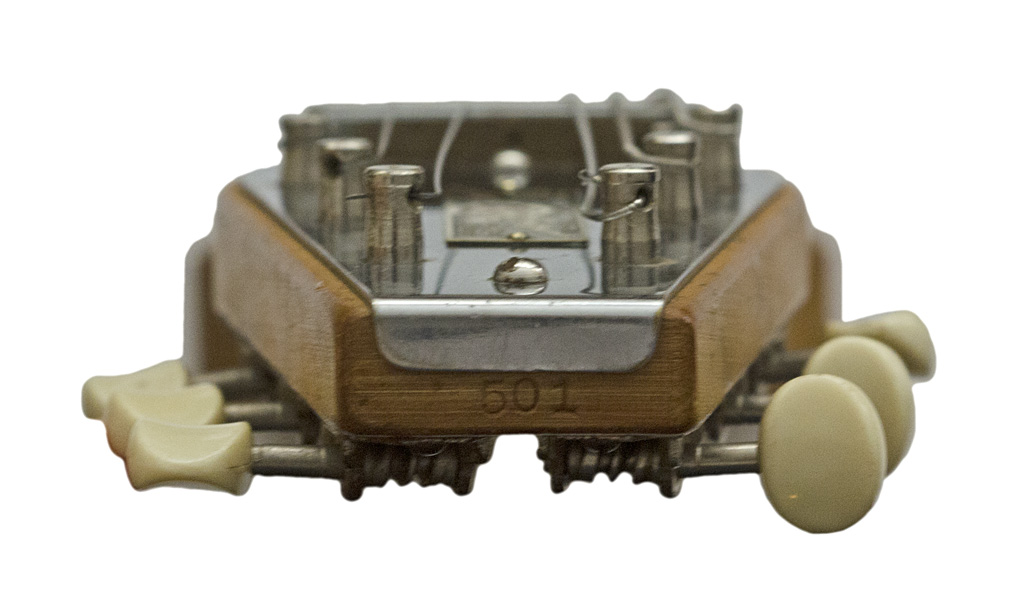
K&F Lap Steel Guitar
Serial Number 45
The earliest examples had painted finishes which were said to have been "baked" in Leo Fender's kitchen oven.
This early example has no logo plate on the headstock and a white plastic nut.
3 lb. 5 oz.
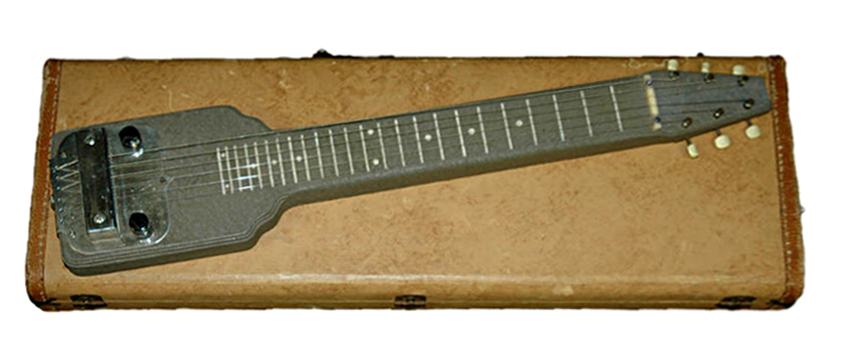
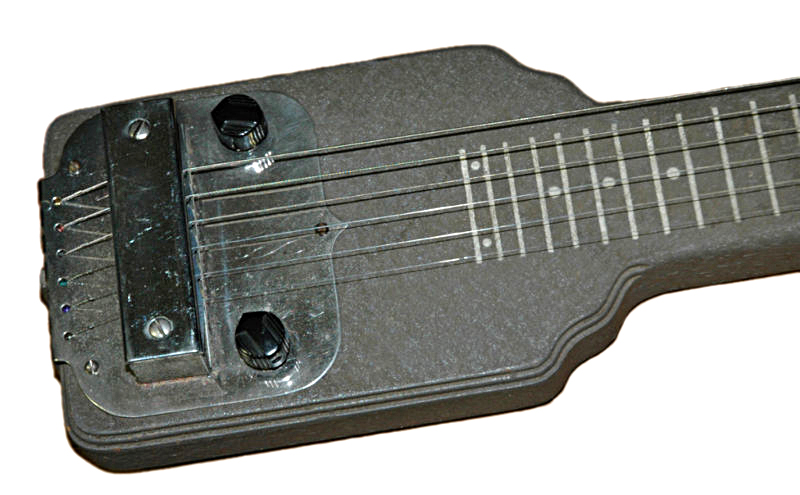
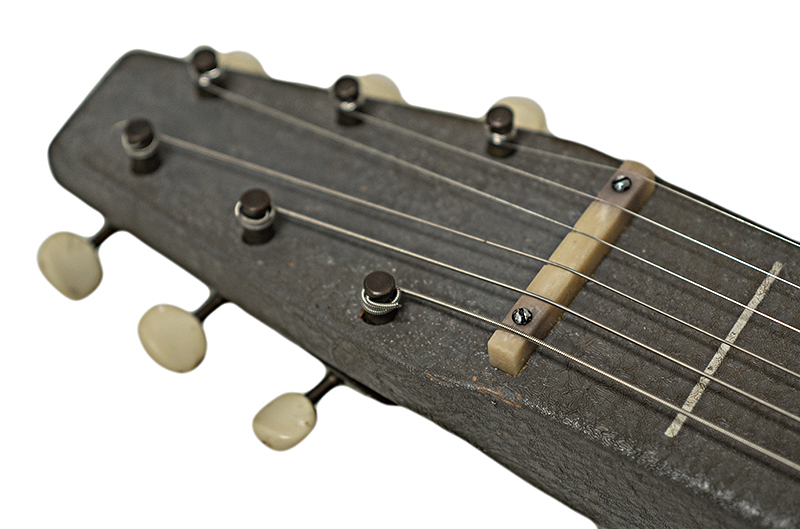
K&F Lap Steel Guitar
No Number
This gray finish example has a logo plate on the headstock with an integrated nut.
3 lb. 10.6 oz.

K&F #322
I first saw photos of this beautiful early example made with bird's eye maple three years ago, and fell into lust, so I was thrilled when it recently showed up on the market.
This guitar had white fret markers painted onto the fretboard, which have since worn off.
The nut is integrated into the headstock.
"Pat. Pend." pickup.
5 lb. 5.8 oz.


K&F #501
Without "Pat. Pend."
5 lb. 5.4 oz.

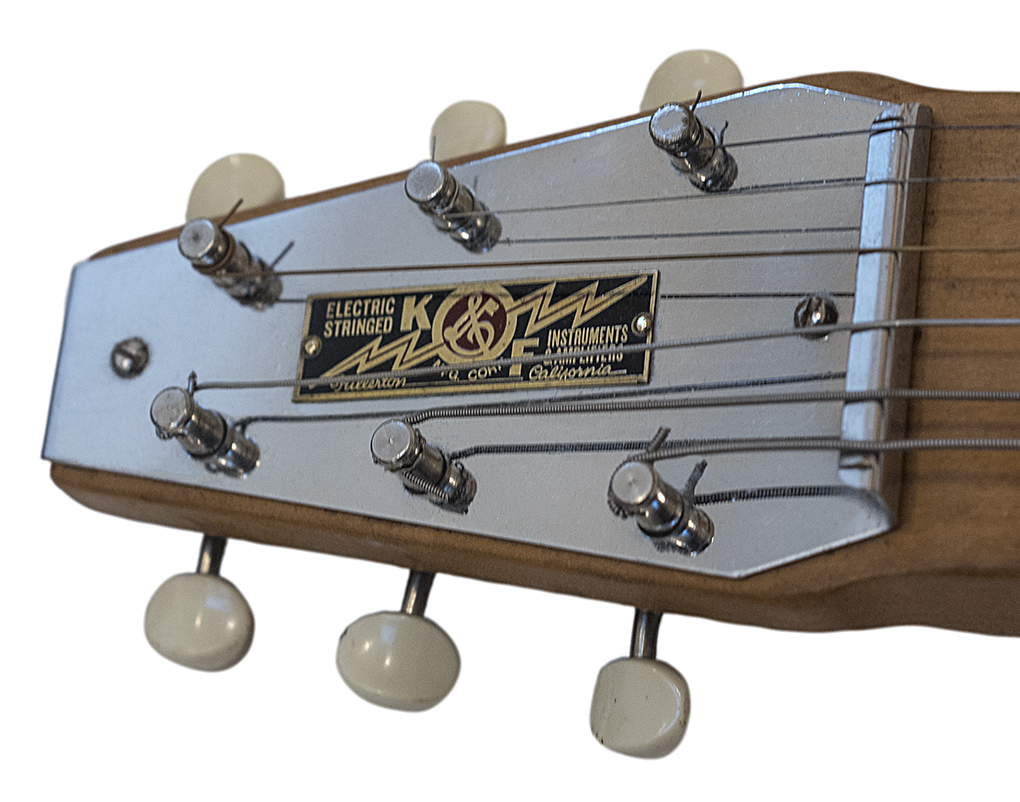
K&F #641
The later K&F steels had a wider curved body and a chrome fretboard with Roman numberals.
6 lb. .8 oz.

Fender #1391
Within a year, Doc Kauffman had left his partnership, and Leo Fender was marketing similar Lap Steels by himself as the Fender Musical Instrument Company.
Shown here with K&F # 641, this early transitional Fender is essentially a K&F steel with a Fender nameplate.
4 lb. 13.2 oz.


The early Fender Company produced three similar lap steels, the Organ Button, the Princeton, and the Deluxe, all with string through pickups similar to the K&F..
1946 Fender Organ Button Lap Steel Guitar
With similar body shape as K&F.
With volume and tone controls, and red button for organ effect.
Lightning bolt on headstock plate.
Available in 1946.
Serial number 1017
1946 Fender Princeton Lap Steel Guitar
The Princeton had a longer body, joining the neck at the 12th fret.
Cord attached.
Available from 1946 to 1948.
5 lb. 1.6 oz.
Serial number A24


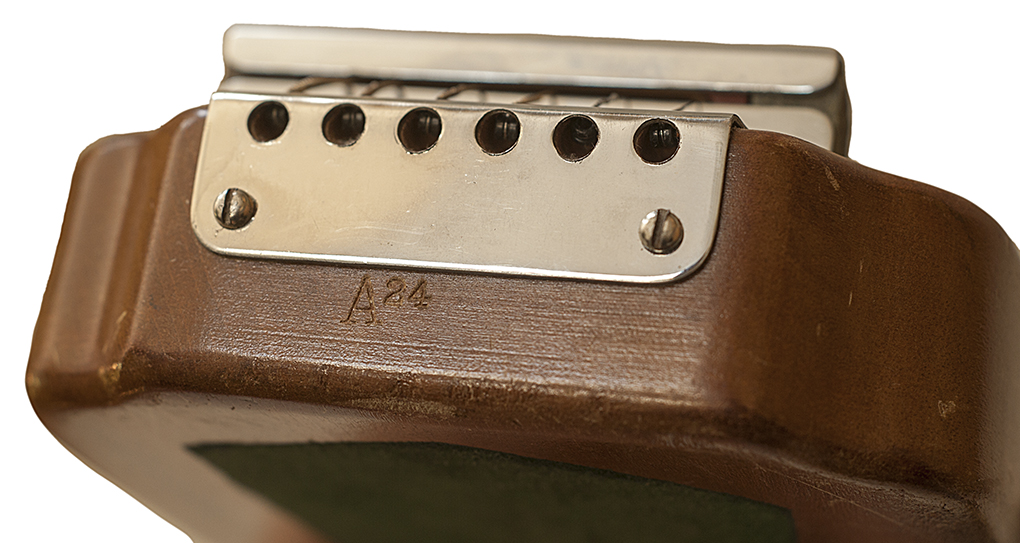
1946 Fender Deluxe Lap Steel Guitar
The Deluxe has a longer body, joining the neck at the 12th fret.
With volume and tone controls, jack for cord.
Available from 1946 to 1948.
4 lb. 10 oz.
Serial number B5
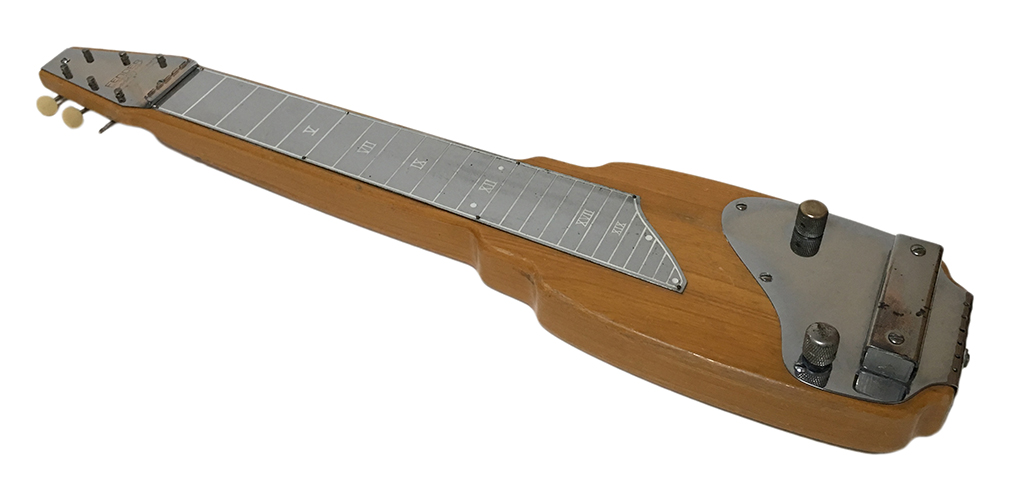
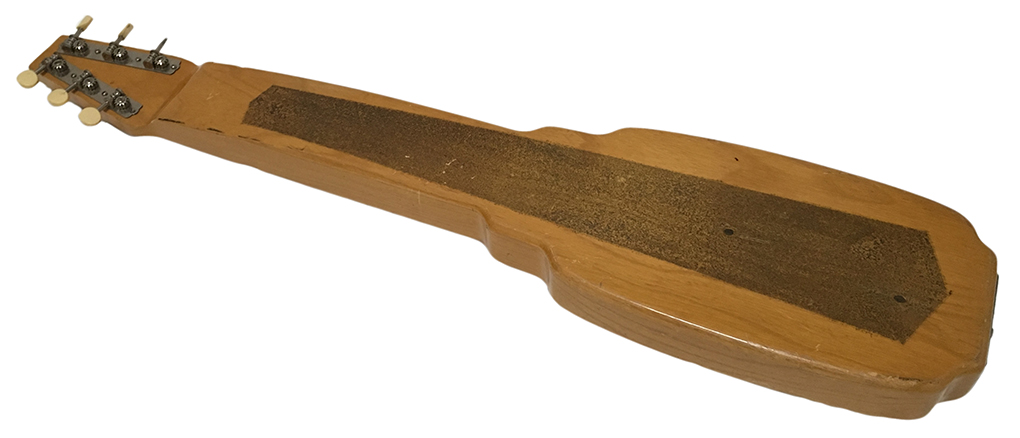
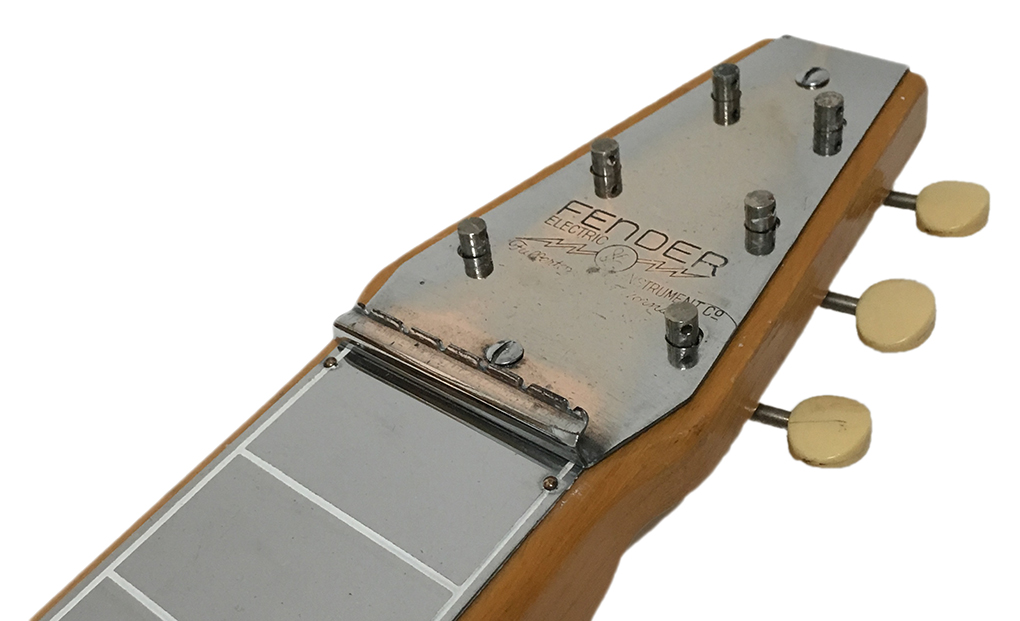
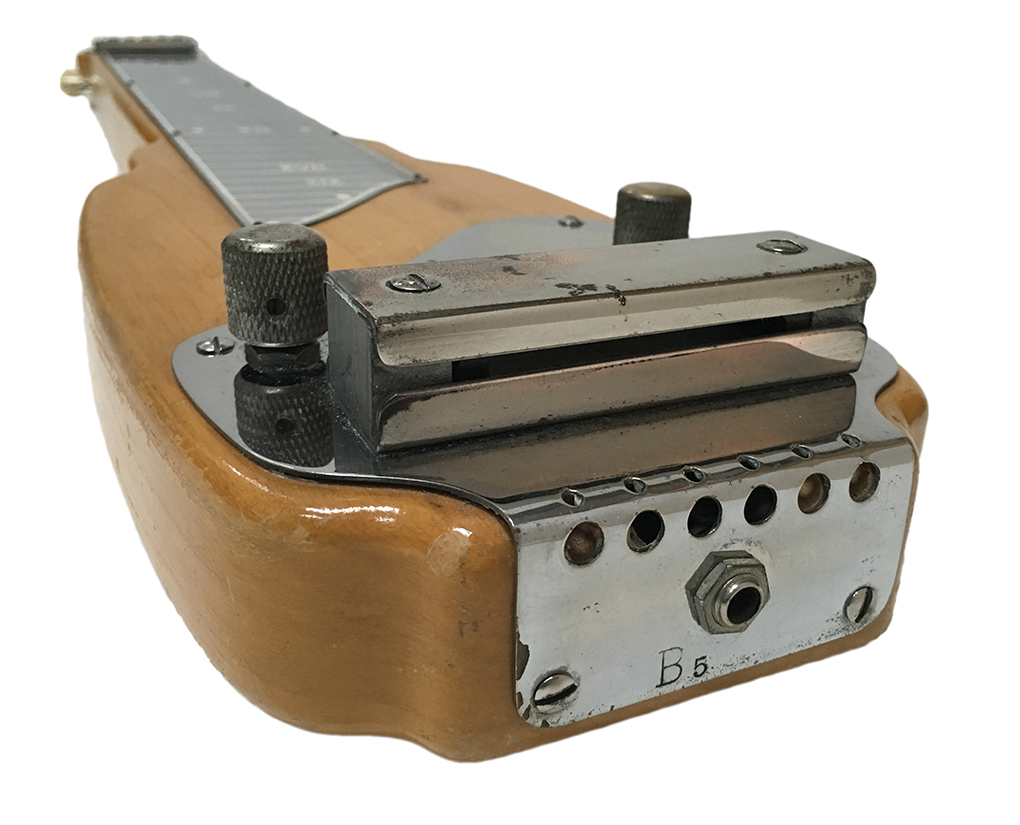
1948 Fender Deluxe 8 Lap Steel Guitar
Available in 1946.
The second version of the Deluxe was available with six or eight strings.
With walnut finish and trapezoidal pickup available in late 1948
No Serial Number
1950's Fender Deluxe 8 Lap Steel Guitar
With features of the multi-neck Stringmaster.
Available from 1950 to 1981
Serial Number 00232
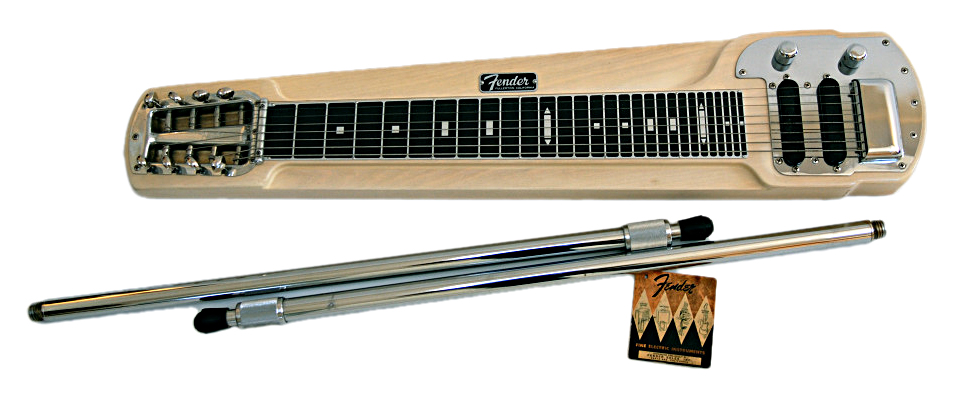
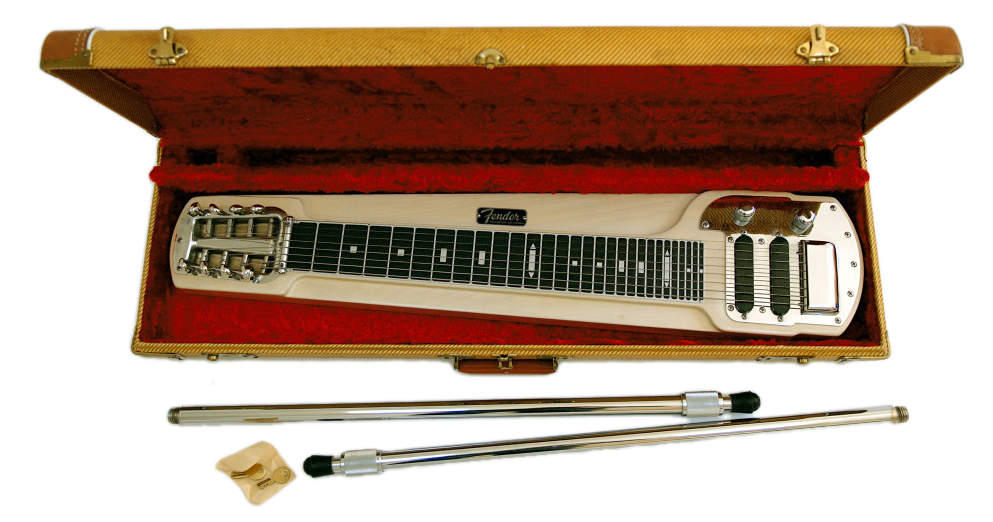
1956 Fender Studio Deluxe
Available from 1956 to 1981
The less expensive Studio Deluxe is lighter, and more rounded vs. the broad, flat sides of the Deluxe 8, with one pickup.
Three legs.
7 lb. 5.6 oz.
Serial number 7215


1952 Champion
The "Student Model" Champion was produced from 1949 to 1955.
The first painted finish was soon replaced by a "Mother of Toilet Seat" version.
Serial number 1266
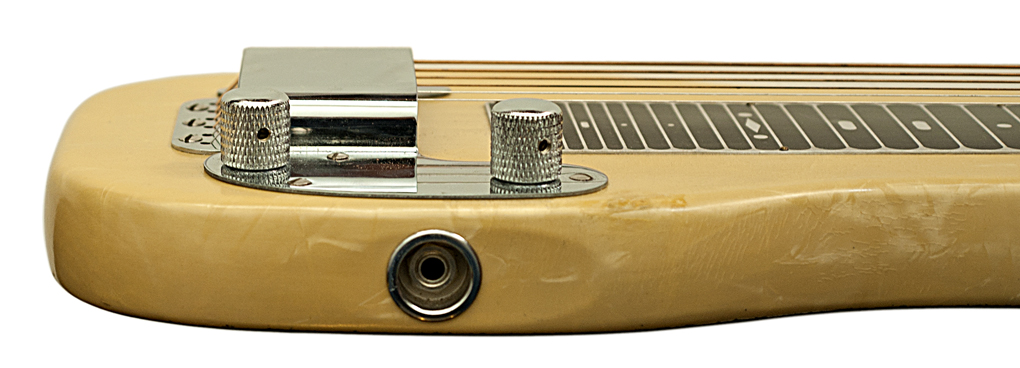


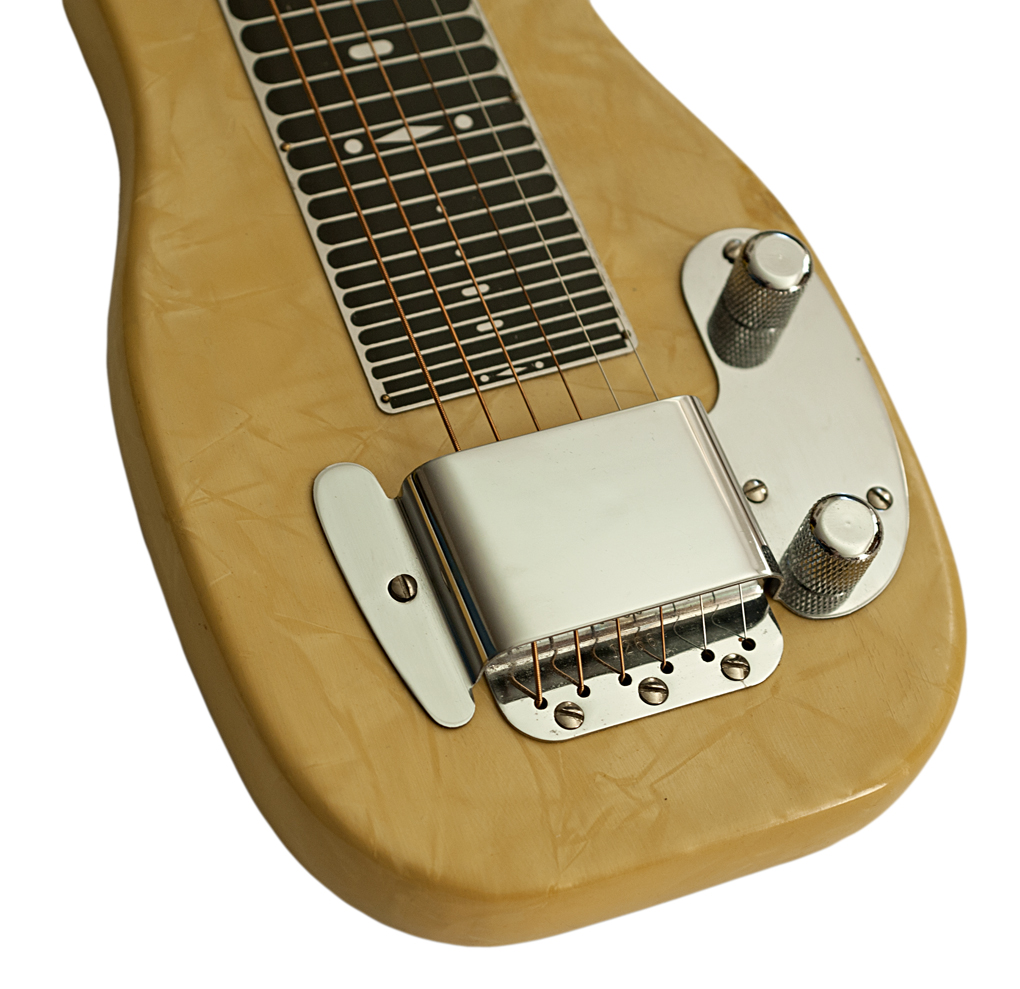
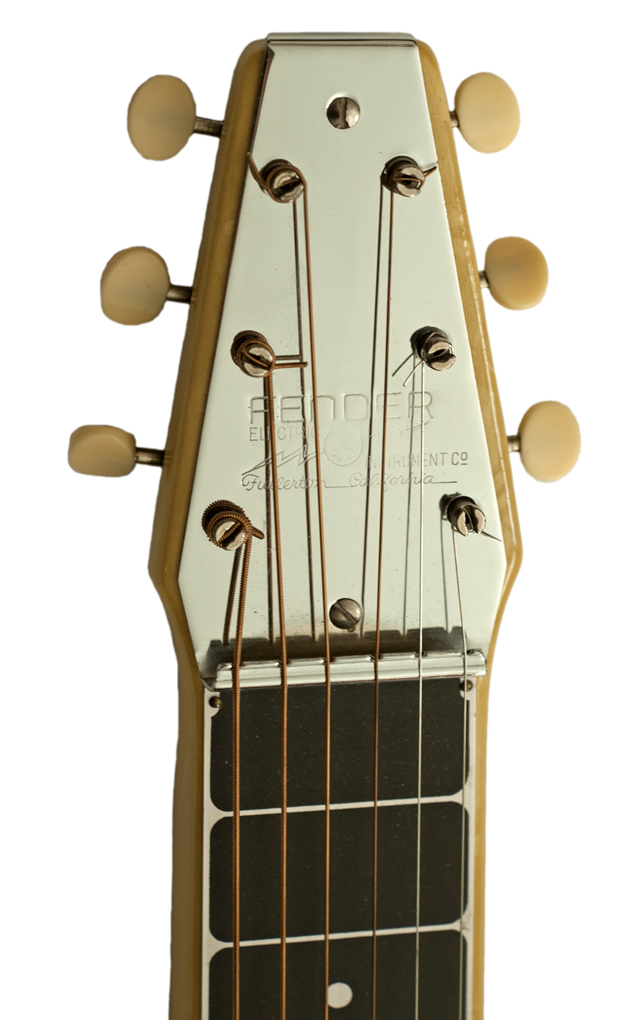
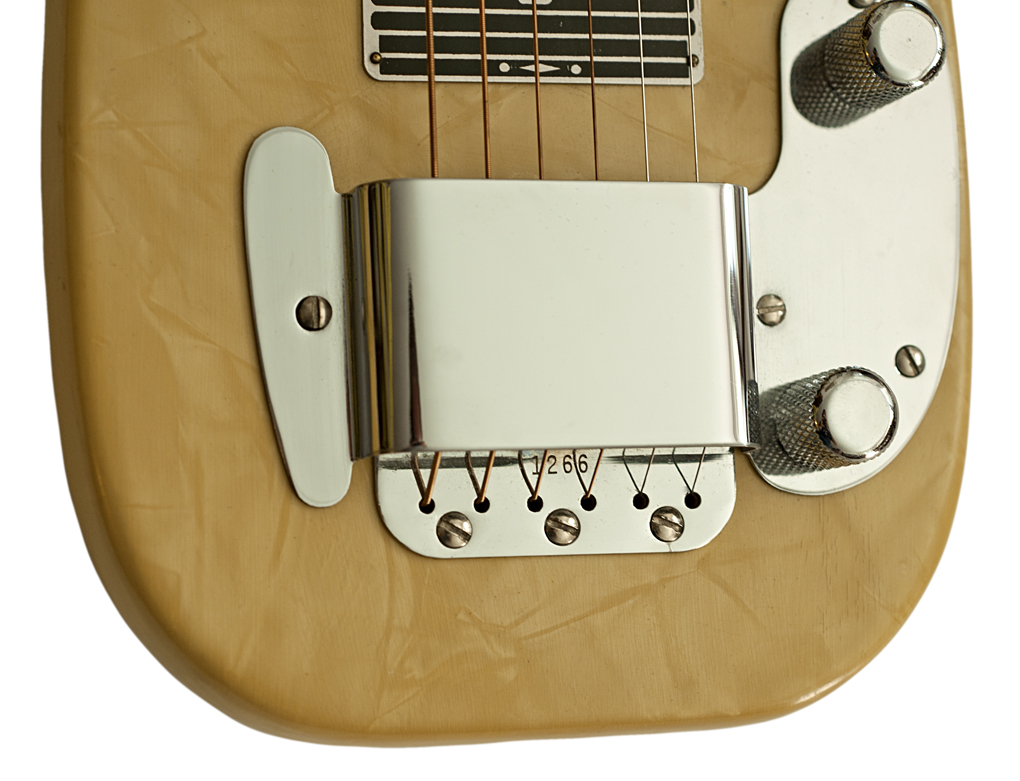
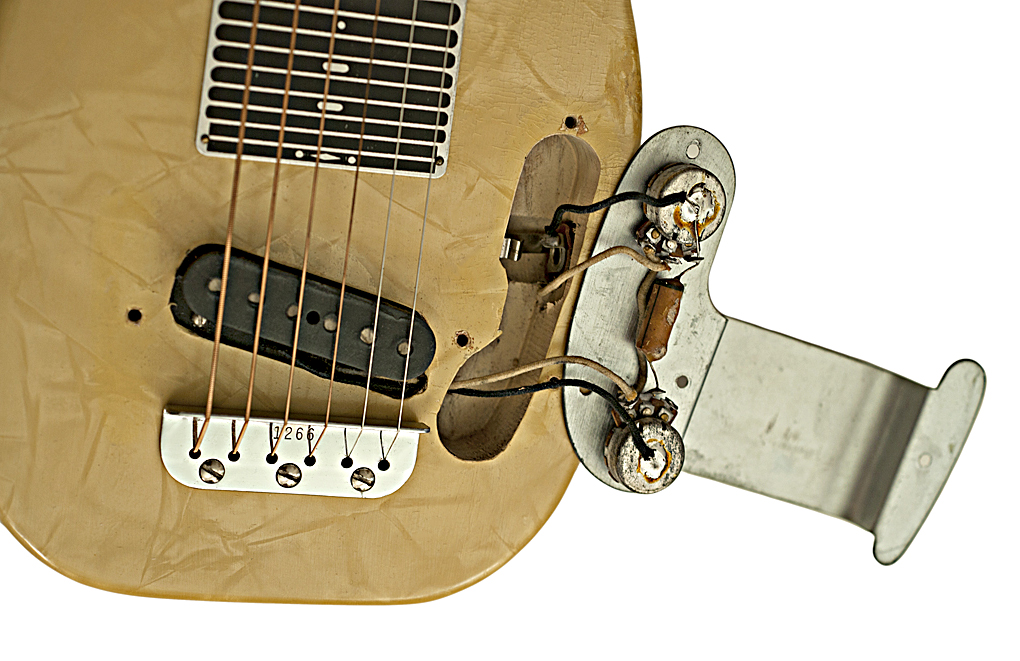
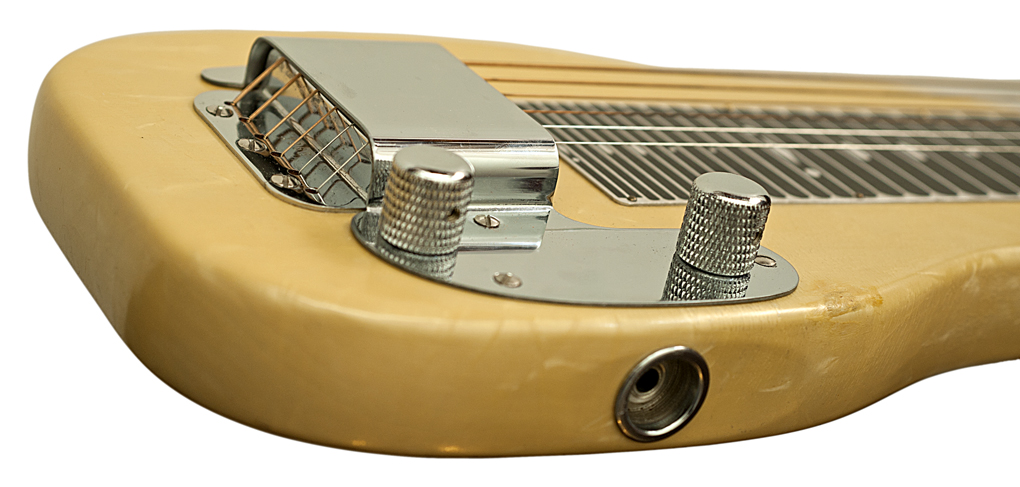
1950's Fender Champ
The inexpensive Champion was replaced by the Champ in 1955.
Six strings - similar to Studio Deluxe, with no legs.
4 lb. 16.4 oz.
Serial number 5368
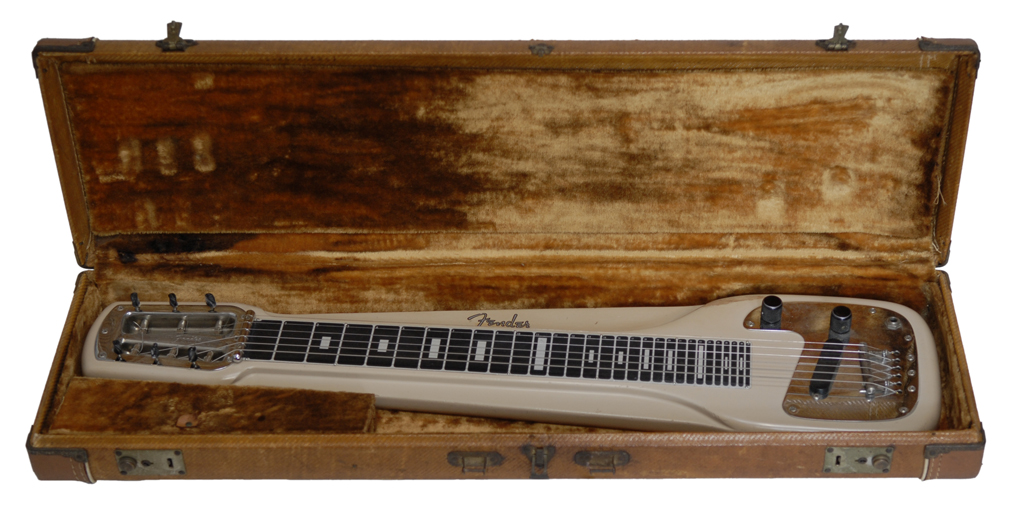



~ CLEANING HOUSE ~
I love these, but I really need to make some room for new ones.
Acoustic Instruments for Sale
Electric Instruments for Sale
I am not in the business of buying and selling guitars, but am interested in purchasing specific unique instruments to round out my collection to present you with a web site with as complete a picture as possible to help you learn. I am interested in substantially original examples made from the 1800's to 1960's by Stauffer, Panormo, Schmidt & Maul, C. F. Martin, Martin & Coupa, Martin & Schatz, Martin & Bruno, Martin & Zoebisch, John Coupa, Oliver Ditson, Southern California Music, John Wanamaker, Wm. J. Smith, Wurlitzer, S.S. Stewart, Orville Gibson, the Gibson Company, and the Larson brothers. I am not hunting for bargains, but seeking quality intstruments at a price that is fair to the buyer and seller alike.
To see Robert's new web site illustrating the development of the Martin Guitar from 1833 to the 1960's, visit:
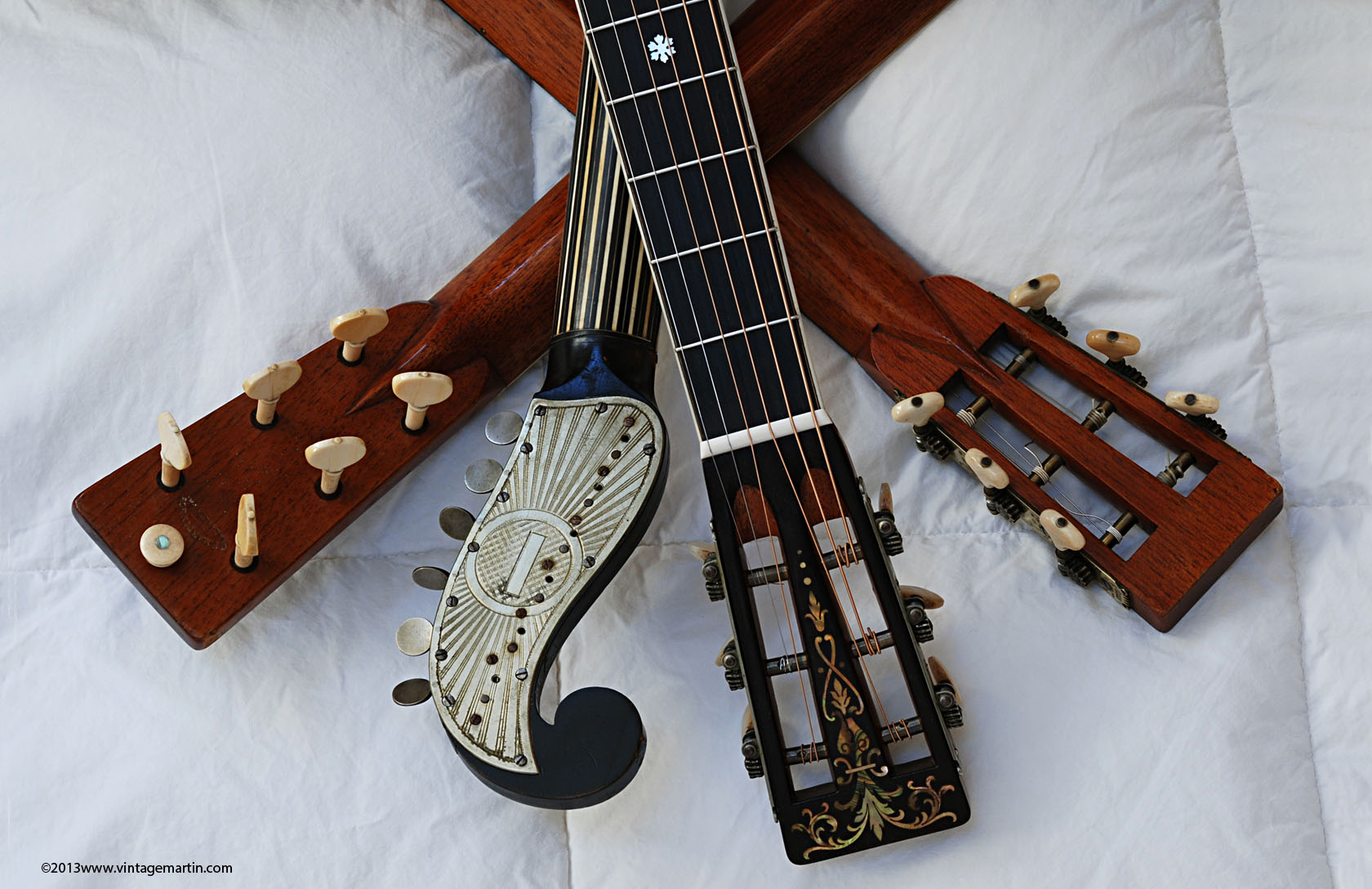
To see Robert's new web site illustrating the development of the Early Gibson Guitar, visit:
earlygibson.com
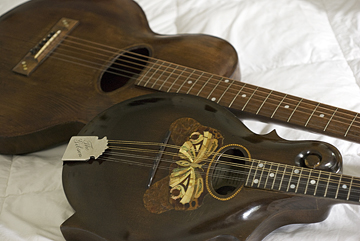
To see Robert's new web site illustrating the development of the post-Orville Gibson Guitar, visit:
oldgibson.com
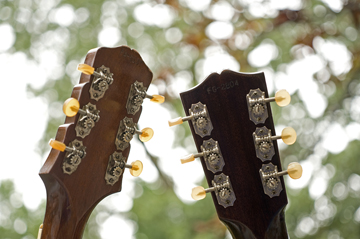
To See Robert Corwin's Classic Photography of Folk and Roots Musicians, visit:
robertcorwin.com
vintagemartin.com
To See Robert Corwin's Classic
Photography of Folk and Roots Musicians, visit:
Exhibition, Publication, CD's, Promotion, Web Pages, Tour Books,
to Purchase Photographic Prints, or
If You Have Questions or Suggestions About This Web Site or Vintage Martin Guitars:
e-mail: Robert Corwinentire site copyright ©1998 through 2016 Robert Corwin/Photo-Arts. All rights reserved.